Letter from the Executive Director
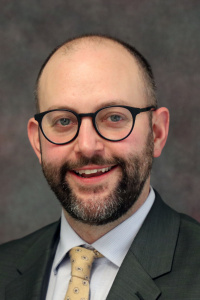 Dear Reader,
Dear Reader,
For the last 12 years, ICPH’s Beyond Housing conference has sparked conversations and convened the community of policymakers, service providers, and others dedicated to supporting the needs of families experiencing homelessness.
When the COVID-19 crisis struck the country in March 2020, that community stepped up in a big way. For many, the pandemic’s toll over the past two years has only strengthened their commitment to finding new and long-lasting solutions for the changing needs of families and communities. At ICPH and our affiliate Homes for the Homeless (HFH), the pandemic has taught us to reimagine the ways we foster community. Due to the nature of the COVID-19 pandemic, we made the difficult decision to forego our regular Beyond Housing conference, which normally draws hundreds of attendees at a major hotel and conference center in New York City.
Instead, this year, we’re bringing you together in a different way—through the launch of our new Beyond Housing magazine, a collection of ideas and solutions around family homelessness. Our team at ICPH is smaller than it used to be, and we’ve tailored our research to more directly address the needs of local families in New York City. Yet, we know that when it comes to family homelessness, local issues are also national issues. Many of the lessons we’ve learned and the solutions we’ve found in NYC can easily be applied to other localities, and vice versa.
In this inaugural issue, you’ll find a Q&A with homeless education liaisons in Los Angeles County and an analysis of the New York City Department of Education’s coordination with shelter-based student services during the COVID-19 pandemic. You’ll read about a partnership in Philadelphia that’s working to foster quality early childcare for children experiencing homelessness and its influence on statewide policy, as well as a NYC shelter-based afterschool Youth Council offering peer leadership opportunities to children and teens.
The Urban Resource Institute, which served as a site visit during the 2020 Beyond Housing conference, will share the latest research on their innovative pet-friendly domestic violence shelter model. You’ll learn how pre-existing housing conditions, like overcrowding and low affordable housing stock, exacerbated the COVID-19 and looming eviction crises in NYC’s immigrant communities, as well as strategies for ensuring that documentation requirements don’t impede a family’s search for housing stability. And Family Promise offers us a glimpse into the work that two of their affiliates are doing to ensure that documentation and identification issues do not keep a family from achieving housing stability, especially for those who are asylum seekers. We’ll also feature some enlightening infographics highlighting data from our research and policy unit’s “Snapshots” on employment, disability benefits, and “new parents” in Homes for the Homeless’ four family shelters in NYC.
Through it all, we’ve seen what community and care can do for families, even—or especially—under the most challenging circumstances. Our communities have consistently stepped up in the face of disaster—including hurricanes, the September 11 attacks, and now, a global pandemic—and each time they’ve emerged with new tools, ideas, and resolve.
I’m deeply proud of this community and the ways in which we’ve supported each other and families experiencing homelessness.
We look forward to hearing your thoughts, comments, and stories, and encourage you to connect with us on Facebook, Twitter, or by email at INFO@ICPHusa.org. You can also visit our website at ICPHusa.org for additional content and more opportunities for collaboration.
Sincerely,
John Greenwood
Executive Director
Homes for the Homeless and the Institute for Children, Poverty & Homelessness
The Data Digest
Data and stats often come up at the Beyond Housing conferences. In “The Data Digest,” we want to share not only data that may shine light on the current state of family homelessness in New York City, but also help providers and others think about how they can approach data collection, analysis, and dissemination in a meaningful way.
All of the data shared in this section is pulled from a series of “Snapshots” that social services provider Homes for the Homeless (HFH) put out over the course of 2021 to take the pulse on programmatic and operational topics from resident employment to needs and demographics of new parents (defined as those with a child under the age of 24 months). The overall goal was for program enhancement and staff development but the data also shed light on key issues that others working with families experiencing homelessness might be interested in hearing more about.
Download the PDF and watch this video for some of the data points that stood out.
How to Connect
Max Rein / Policy Assistant, MRein@HFHnyc.org
Caroline Iosso / Senior Policy Associate, CIosso@HFHnyc.org
To access the full Snapshots, click the links below:
Resident Enrollment in Disability Programs
‘The Rules Change Daily’: Documentation and Homelessness Prevention
By Sadie Keller
Lisa Markushewski, case manager at Greater Portland Family Promise (GPFP) in Portland, Maine, has recently found herself somewhat of a specialist in identification and documentation. This is not a skill she expected to develop while working to keep families housed and stabilized.
Amid applying for housing, acquiring necessary social services, and building community ties, most families in GPFP programs are simultaneously embarking on a long and arduous legal journey. According to GPFP Executive Director Michelle Lamm, most of the families served by the organization are new residents of the United States. Ninety-three percent of families served are seeking asylum, the majority from central African countries like the Democratic Republic of Congo and Angola.
To respond, the GPFP team has ventured into the complex lattice of state and federal laws that dictate social services, immigration status, and housing. “You have to go back and read the guidelines,” says Markushewski, “and the rules change daily.”
Watch this video for a deeper look into this topic.
This navigation requires collaboration from an entire community, and thankfully, the GPFP has strong partnerships with legal advocates, including Maine Equal Justice. They refer multiple families to the group each year. Attorney Deb Ibonwa, the organization’s policy and legal advocate, connects families to services, provides legal assistance, and manages high-impact litigation. Ibonwa says GPFP’s team identifies when a family faces a legal challenge, like a loophole eviction, tax fraud, or denied benefits. “I rely on [GPFP’s] advice and insight into the issues families face in our community,” says Ibonwa.
Initiating and winning an asylum claim is contingent on having multiple forms of ID and valid certificates, a significant barrier for some families. Administrative snags and international incongruence add to the stress. For example, a person may struggle to track down a birth certificate and request it from their home country. In the case of married couples, the United States may not recognize a union carried out in another country through a traditional ceremony.
When possible, GPFP gets creative. They have acted as notaries for at least six couples, performed legal marriages onsite, and have helped families obtain state-issued photo IDs. While they leave the legal work to experts, GPFP works with families to prepare their asylum claims, including copying documents needed for the application. Claims can involve more than 250 printed pages, so donors have provided credit at local printing stores to help cover the costs.
Gathering required documentation can take months, which means families may live without access to benefits pending their verification. “Too many families are forced to go without basic needs for their children,” says Lamm.
T.J. Putman is executive director of a Family Promise affiliate on the other side of the country, Family Promise of the Mid-Willamette Valley, in Salem, Oregon. Like GPFP, the organization does not require a family to present documentation to enroll in programming, including emergency shelter. “You shouldn’t need an ID to live somewhere safe,” says Putman.
Before working in homeless services, Putman could understand why someone would live without identification, but he did not know the extent to which a lack of documentation would keep a family on the brink of experiencing homelessness. He has been continuously surprised by the centrality of documentation to his work supporting families, noting, “You need documentation to open a bank account, to drive, to apply for an apartment, and to secure a job.”
When they first approach a Family Promise affiliate, most parents are focused on getting out of an unsafe situation and caring for their children. Understandably, renewing a driver’s license is not top of mind. In Portland, many families contact GPFP after an exhausting and traumatic international journey that may have taken months or years. “At intake, all of the families we serve need serious medical attention. They are deeply concerned about their kids,” reflects Markushewski.
Obtaining documentation can feel tedious and bureaucratic, but it has proven to be a necessary checkmark in case management. It is essential to bringing a family out of homelessness—and can bring a family’s long-term goals a little more within reach. “We can work with some landlords to get a family into an apartment and pay for one or two months of rent,” says Lamm. “But eventually, the family will pay. Parents need to have a job or be in training, kids need to be enrolled in school, and everyone needs good healthcare. Each piece of that puzzle requires different forms of ID.”
Under normal circumstances, documentation poses barriers for those living in poverty, and overwhelmingly burdens families of color. The COVID-19 pandemic has further complicated this situation, increasing the wait time for processing credentials and limiting in-person visits at the responsible state offices. In one timely example, ID or Social Security Number requirements for the coronavirus vaccine have kept some families from receiving a dose in some states.
The past two years brought an unprecedented level of funding to renters and landlords, including $46.5 billion in rental assistance. Yet the dollars have been slow to reach those who desperately need them. Some localities, fearing misuse of funds or fraud, have put in place strict requirements that mean it can take offices weeks to verify an applicant. One of the biggest hurdles in the process is the level of required documentation needed. Hoping that states and local governments can streamline the distribution of the funds, the Treasury Department has modified its guidance. It remains to be seen how effectively these funds will be distributed. Family Promise and other organizations fear the long-term repercussions of the end of the national eviction moratorium for families who were unable to access or use allocated funds to catch up on rent.
As they navigate ever-changing webs of federal, state, and local rules, both Family Promise affiliates see opportunities for policymakers and administrators to better support families. In Portland, LD 718, HP 529, an act introduced in the past legislative session, could help close gaps in healthcare eligibility for asylum seekers. The act is currently being re-considered in the current legislative session, and GPFP is hopeful it will be adopted. According to Lamm, the change would help ameliorate health inequities of low-income Mainers who are immigrants and allow case managers like Markushewski to better advocate for their clients, but it is just one of many more substantial changes needed in Portland’s social safety net.
In Oregon, one existing service needs to be strengthened. The state provides no-cost birth certificates for people experiencing homelessness, a helpful tool for Putman’s team as they update and establish documentation for families. But the process is slow, often taking more than 30 days, and COVID-19 contributed to a domino effect. The backlog stalls a family’s ability to access a hotel for one evening, and in the long-term could keep them from receiving essential services.
Ironically, the wait for the special documentation can close a window of opportunity for a family to find housing. In today’s especially tight real estate market, there are few units that families can afford, and when family-suitable and safe spaces do appear, they go quickly. In rare instances, a landlord or organization will accept an interim card as identification. Often, however, no documentation means no apartment.
They live on opposite coasts and serve disparate communities, but Markushewski, Lamm, and Putman all agree that securing documentation is a necessary step to preventing homelessness and maintaining a family’s independence in the long term. Therefore, they believe it is a natural part of the work of homeless services providers. As they work to educate their communities about family homelessness and housing instability, the Family Promise teams are expanding the definition of homelessness prevention to meet the need in their community.
As Lamm says, “It is all about setting the family up for stability.”
Sadie Keller is a policy and program associate at Family Promise, where she focuses on housing policy research, grant management, and partner engagement. What began as a local initiative in Summit, NJ, has become a national movement that involves 200,000 volunteers and has served more than one million family members since its founding. Currently, Family Promise is working in more than 200 communities in 43 states to prevent family homelessness and ensure that families have a safe place to call home and the resources they need during the COVID-19 pandemic.
How to Connect:
Sadie Keller / skeller@familypromise.org
Michelle Lamm / michelle@gpfamilypromise.org
T.J. Putman / tj@familypromisemwv.org
familypromise.org
gpfamilypromise.org
familypromisemwv.org
Creating a Community of Care: DV Survivors, Homeless Families, and Their Pets
By Danielle Emery

Launched in 2013, the People and Animals Living Safely (PALS) program, an initiative of the Urban Resource Institute (URI), serves domestic violence (DV) survivors with pets. Our shelters are among the less than five percent of DV shelters nationwide to offer co-living, where people are housed along with their companion animals in individual units while healing, helping survivors and their entire families access safety.
The PALS program operates at the intersection of social services and animal welfare. Research has shown that when there is violence in a home, all members of that home—both people and animals—are at risk and need access to safety. We also understand that pets are an integral part of a family, and especially acknowledge the importance of the human-animal bond for those who have experienced trauma. URI released “The PALS Report and Survey” in May 2021, including the findings of a 2019 survey conducted with the National Domestic Violence Hotline. The survey reinforced the notion that pets are an important part of a survivor’s family, with 91 percent of respondents saying their pet was critical to their own survival and healing, and 97 percent stating that keeping their pet with them was an important factor in seeking shelter. Additionally, concern for a pet’s safety and the lack of family shelters that can accommodate pets are critical reasons why survivors may delay leaving an abusive situation or return to a dangerous environment. Fifty percent of respondents to the PALS survey said they would not seek shelter if they could not take their pets with them. This data corresponds with what experience in the field has consistently shown: pets are essential in survivors’ lives, and the lack of programs that include animals as family members is a significant barrier to accessing safety.
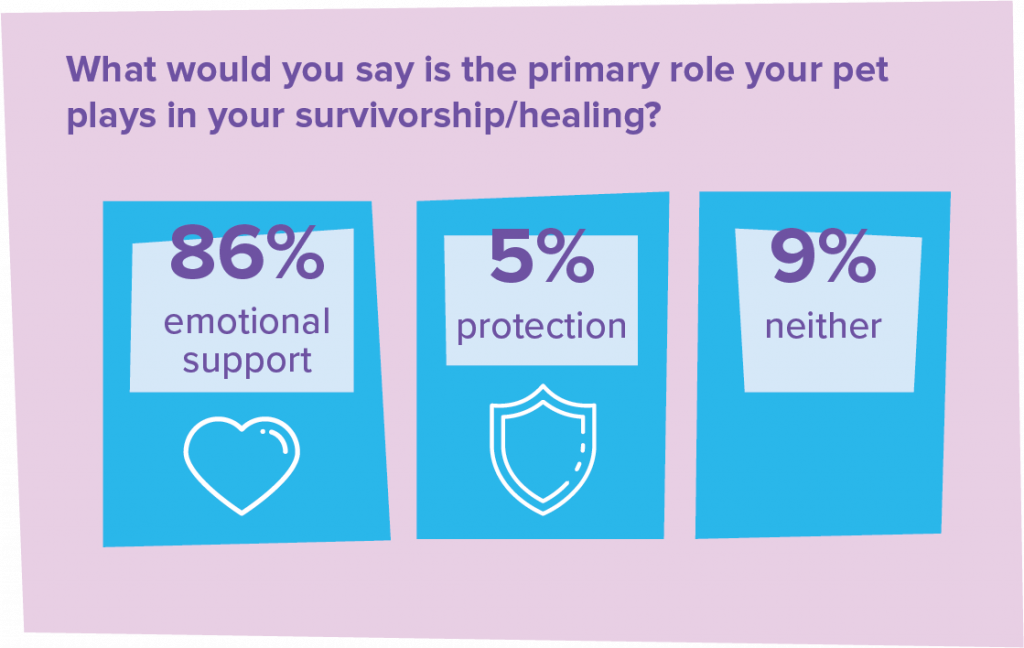
It is also impossible to disentangle domestic violence from family homelessness. Domestic violence shelter systems across the country are intended to provide emergency respite for survivors in crisis. By design, survivors who enter these shelters leave behind their homes and belongings for safety, more often than not becoming homeless in order to flee abuse. New York City’s city-funded domestic violence shelter system is vast, housing 6,400 adults and children each year, but remains woefully inadequate to accommodate every DV survivor seeking safe shelter. A 2019 NYC Comptroller’s report identified domestic violence as the leading cause for homelessness within the NYC homeless family shelter system—over 41 percent of families cited it as the primary reason—a dramatic 44 percent increase over the preceding five years. It is imperative that agencies providing shelter and services to homeless families be aware of and sensitive to the intersection of homelessness and domestic violence, and be equipped to accommodate families with pets in order to help as many survivors as possible.
At the 2020 ICPH Beyond Housing conference, URI hosted a site visit to PALS Place, the first domestic violence shelter of its size built specifically with pets in mind. We talked about our journey to success, from burgeoning idea to impactful and growing initiative, and as a shining example of what is possible with the co-living model. We started as a domestic violence shelter provider dedicated to serving our clients, noticed a gap in those services for clients with pets, and chose to act to fill this need. We are now in a position to share the lessons we’ve learned during this process and are pleased to have this opportunity to provide more information on where we started and updates on how far we’ve come since that 2020 visit, in hopes that it will jumpstart similar initiatives around the country.
Incorporating Pets into Shelter Settings— Addressing Concerns
When URI first launched the PALS program in 2013, we could not have imagined that within eight years we would have successfully welcomed close to 350 families and 450 pets to the program. What began with 10 pet-friendly units in one shelter facility has since grown to nearly 500 units in eight fully pet-friendly shelter buildings across New York City. On any given night, more than 50 families with close to 75 pets reside in URI’s shelters. Although all 500 units are designated as pet-friendly, DV survivors both with and without pets utilize the units on an as-needed basis. This did not happen overnight. As more people learn about the program, we have more families with pets entering our doors. The growth and success of the PALS program has been steady, at a pace matching our organizational capacity, funding, and resources — all important things to consider when taking on this type of initiative.
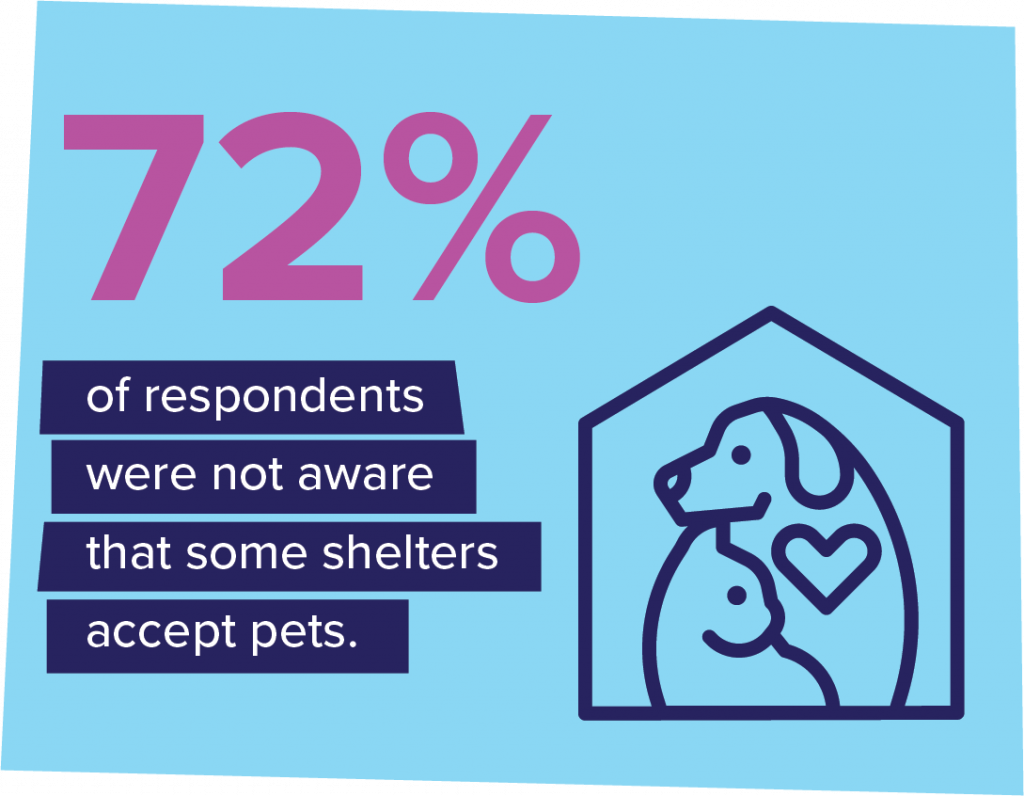
We started the PALS program without program-specific staff and with no institutional experience welcoming animals in our buildings. This was unfamiliar territory for our agency, and there were many concerns and anxieties from staff and residents: “What about allergies?”, “What happens if an animal becomes aggressive?”, “Will I have to interact with animals?” PALS has fielded these questions internally as the program has expanded to multiple URI shelters. The average social service worker is already busy. The average shelter has few vacancies, with some maintaining waiting lists depending on the locale. So, the new and complicating factors involved in adding people’s pets were an understandable source of worry for both staff and residents. Additionally, most of our staff members did not begin working in social services with the intent of working in close proximity to animals. But we understood that by welcoming pets into shelter, we were able to welcome more humans into shelter. We knew the need for pet-friendly shelter was pressing, and we were determined to build a program that would address these concerns while still providing a critical service to survivors.
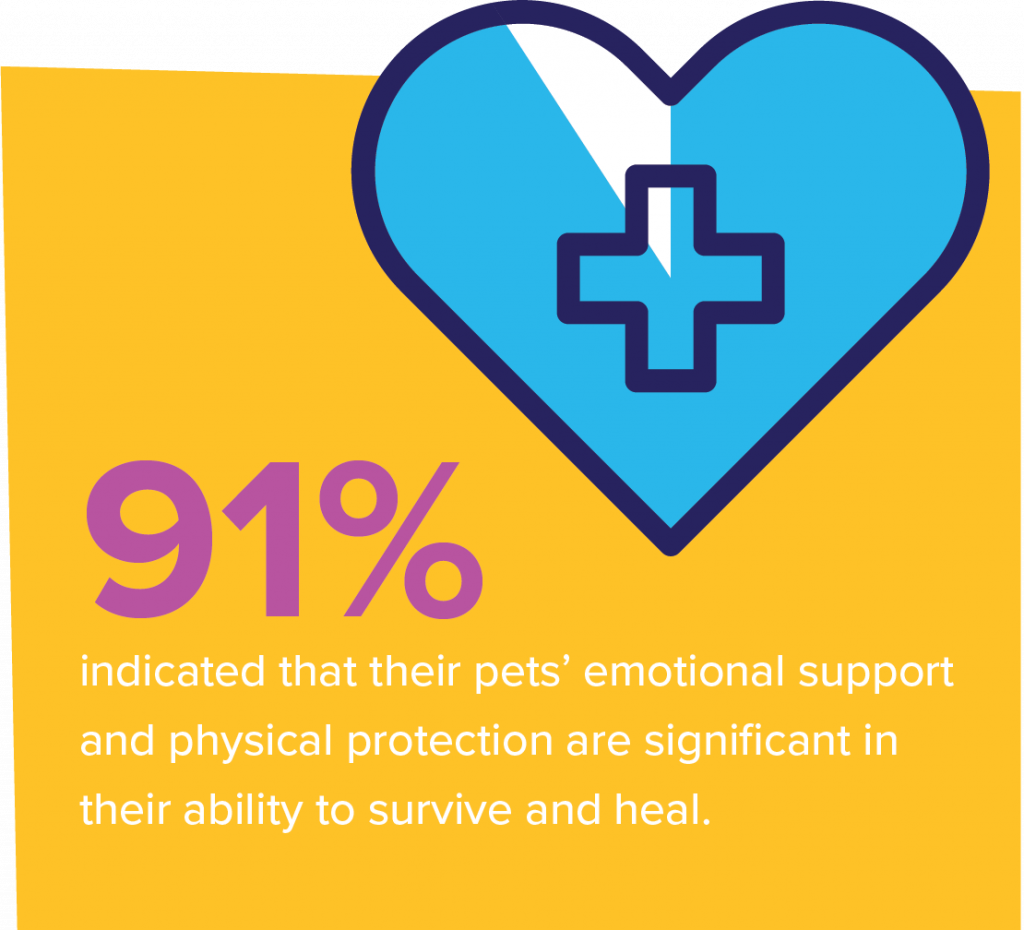
In our experience, these anxieties and fears have been unfounded. To date, no staff member or resident has been injured by a pet. Allergies are not a frequent issue. Animals are not running loose or presenting a frequent disturbance to the shelter environment. Providers can avoid potential snags in their pet program by designing a strong initiative and addressing such concerns and needs before animals are ever brought into shelter. The work we did in designing, implementing, and scaling our program as our capacity grew has been key in our success.
The vast majority of PALS pets are dogs, cats, and other small animals. They are pets who have been part of the family for at least a year and are very familiar with bustling city life, interacting with children, and with the noise and congestion that comes with apartment living. Children and adults alike have strong bonds with these animals. Our intake process includes a number of questions designed to determine the pet’s temperament, and we find that dogs, both large and small, are often socialized to be friendly to or ignore strangers. Those that may not have been well socialized due to abuse or other factors are kept under close watch by family members to avoid incidents in shelter.
For those entering shelters due to domestic violence, the process of entering shelter can be a physically and emotionally draining endeavor. We ask a great deal of our clients: they must show up to an unfamiliar location, sometimes giving up or changing a job for their safety. We also ask them to apply for public benefits, so that they can access all available services. While living in a shelter, they must comply with curfews and other rules that may be new to them. In allowing residents to keep a family pet, we are giving them some peace of mind and a stable source of comfort. Retaining their pet means they do not have to separate temporarily or permanently with an important member of their family. It also means that children—and adults—do not have to be further traumatized by separating from their furry friend.
Once new clients with pets are accepted, they must speak with a member of the PALS team to discuss the expectations and responsibilities for having a pet in the shelter setting. Just as clients are expected to meet curfew and other guidelines on site, they must also be responsible for the care of their pet and agree to avoid unnecessary interactions between their pets and other residents. Once clients have acclimated, many staff members at URI say that it’s easy to forget that there are pets residing at their site, since clients take such attentive care of their animals.
We in the PALS program want to share this experience with providers across the country to assure them that while we had fears and anxieties when starting our program, in our nearly 10 years of experience, the benefits have far outweighed any concerns. When handled appropriately, introducing a pet program into your shelter can be another avenue in which you can connect with your clients, reduce trauma, and encourage their positive growth.
Creating a Community of Care
When URI began exploring how to welcome pets into our shelters, we knew that collaboration with other providers—particularly those specializing in animal welfare—would be integral to our program’s success. No single service provider can address every aspect of the complex and unique life experiences of a DV survivor or family experiencing homelessness. Collaboration with animal welfare organizations in your community are paramount to the success of any co-sheltering program. Fortunately, many in animal welfare are ready and willing to work with shelter and social service providers to expand services, keep families together, and prevent pet surrender.
The field of animal welfare has been moving towards a more people-centered approach to helping animals in need, recognizing that caring for animals requires caring for the people who love and care for them. This change has been especially notable over the past two years, as both animal welfare and social services have responded to the COVID-19 crisis. For many Americans, changing employment circumstances and public health measures enacted in response to the pandemic resulted in an extraordinary amount of time spent at home. Animal rescues experienced an unprecedented rate of pet adoptions, and many across the country reported that their pets were a significant factor in managing stress levels during otherwise isolating times.
As a shelter provider, we know this work is complex and demanding, and are not suggesting that agencies immediately begin accepting pets into their facilities. But we are encouraging potential providers consider the issue and begin exploring ways your agency could provide support and resources to people with pets. We and others doing this work across the country are available to provide guidance and direction. URI and PALS can provide training and technical assistance, and resources and training opportunities are also available via the Co-Sheltering Collaborative, Red Rover, SAF-T, Human Animal Support Services, and others.
PALS operates with the belief that all people who have animals in their families deserve access to resources and services in order to remain together, no matter what compounding factors they are experiencing. This includes survivors of domestic violence and both individuals and families experiencing homelessness. But no one is suggesting you do this work totally on your own! Service providers and organizations can and should collaborate across disciplines to contribute to a community of care that addresses all of the needs of individuals and families recovering from domestic violence and experiencing homelessness, including provisions for family pets.
Pushing for Change
There are a number of actions that individuals, agencies, and advocates for policy change can take in advancing resources available to domestic violence survivors and those experiencing homelessness with pets. If you work with clients, collect data on the number of families and individuals you serve that either have pets, or recently relinquished or re-homed pets due to their circumstances. Your local animal shelter may already have some of this data regarding the animals that come into their care—working with them to compile comprehensive data will help you understand the scope of the problem and provide ammunition in advocating for policy change and funding in your community.
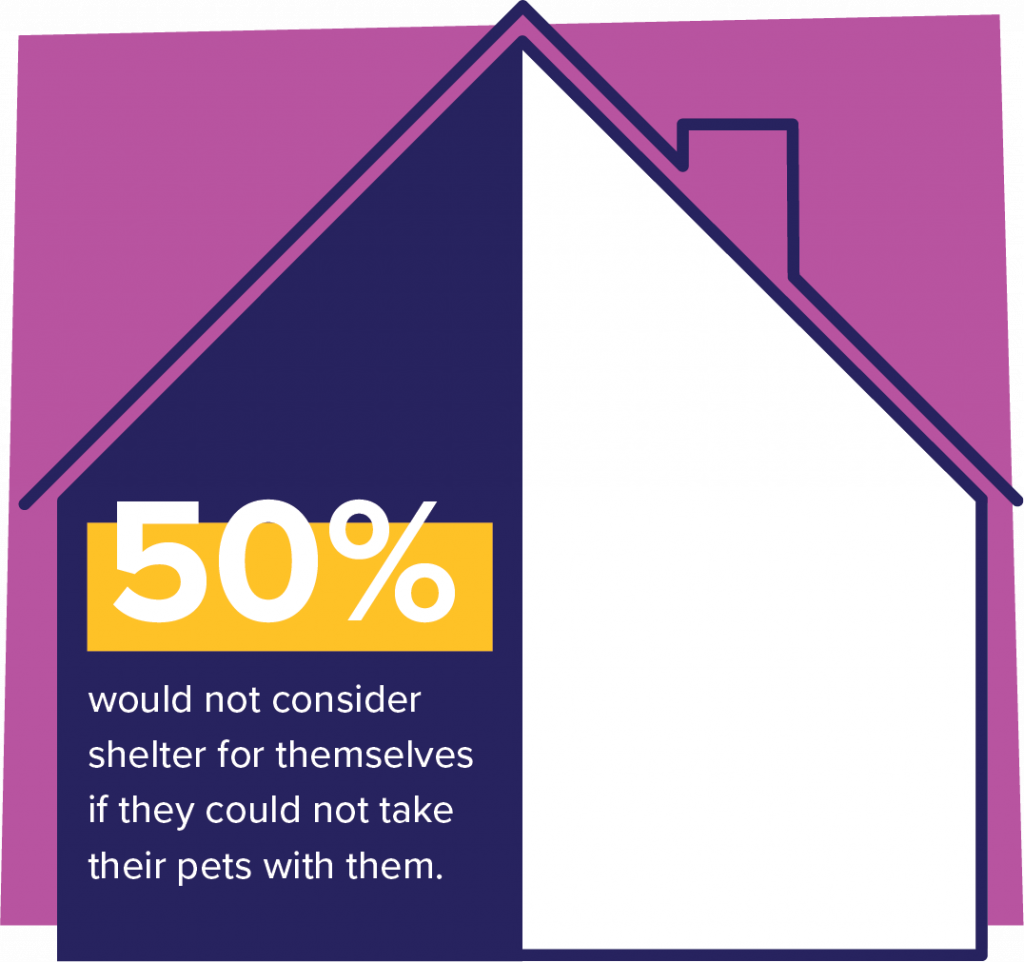
There is funding available to providers across the country to support co-sheltering and other programs geared toward helping people and their pets. Originally passed as part of the 2019 Farm Bill, the bipartisan Pet and Women Safety (PAWS) Act is a grant program that provides Congressional funding to enable domestic violence shelters to become pet-friendly and allow survivors and pets to seek safe shelter. In the last two years, the PAWS Act has distributed $4.5 million to providers across the country to support programs for domestic violence survivors with pets. Pet Smart Charities, Red Rover, and other small foundations also have grants available for all types of human services agencies seeking to provide supports to clients with pets.
If pets are present in your or your loved ones’ lives, as they are in nearly 70 percent of American households, consider the joy and comfort they provide and use that experience to advocate for others with pets. There are actions both small and large you can take to help those experiencing homelessness with pets, and there is assistance available no matter what level of action you are looking to take. Reach out to other providers in your community, begin or continue conversations about how to incorporate pets and how that ultimately serves human clients, and most importantly, ask for help! Only by working together can we move towards a shelter system that recognizes the importance of animals in people’s lives and provides supports and resources to keep families together and safe.
Danielle Emery is the People and Animals Living Safely (PALS) director at Urban Resource Institute (URI). For almost a decade, the organization has offered training and technical assistance on the PALS program to all types of providers, including domestic violence and other social services, as well as to animal welfare organizations. URI helps transform the lives of domestic violence survivors and homeless families with a focus on communities of color and other vulnerable populations. URI is the largest provider of domestic violence shelter services in the U.S.
How to Connect:
Danielle Emery / Demery@URInyc.org
URInyc.org
Resources:
Watch this video for a deeper look into the topic:
To learn more about the URI and National Hotline for Domestic Violence report mentioned in the article, download the Executive Summary.
The Saratoga Youth Council: Giving Youth Experiencing Homelessness a Platform for Individual Development and Community Building
By Mary Cummings, Max Rein, and Michael Chapman
Note: Citations and sources for data are included in the PDF version of this document available by clicking Downloads underneath the Table of Contents.
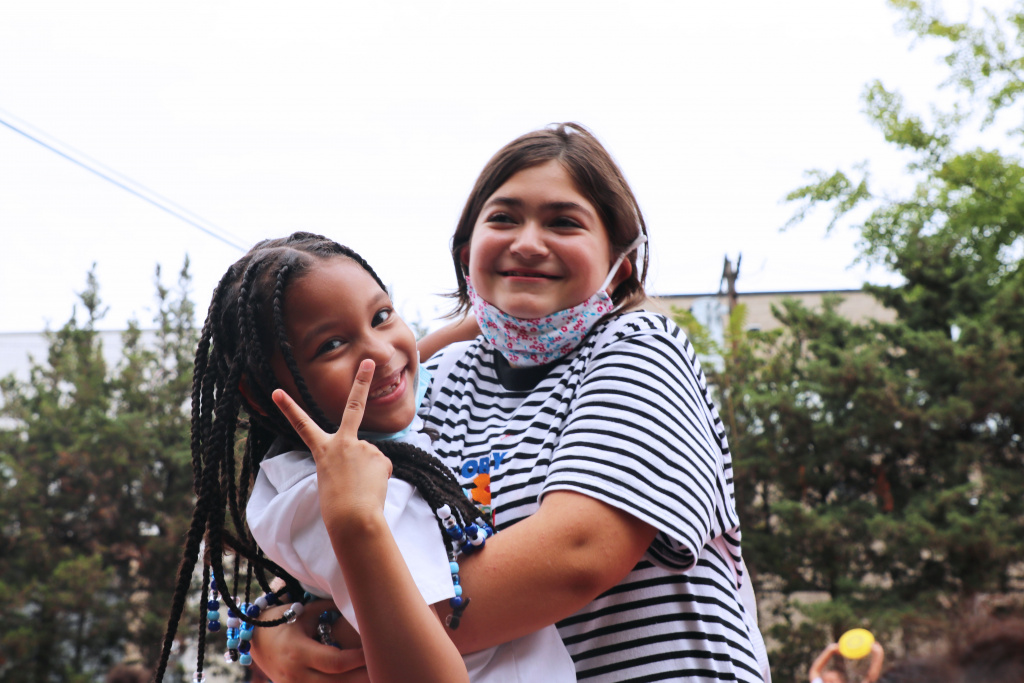
The issues facing today’s adolescents range from peer pressure and cyberbullying to climate change and a global pandemic. For students experiencing homelessness, factors like housing instability and stigma make an already difficult stage of life even more challenging. Afterschool programs across the nation are working with youth from all backgrounds to empower and support them as they navigate these circumstances.
“Students whose families are experiencing homelessness benefit tremendously from afterschool programs,” says Jodi Grant, Executive Director of the Afterschool Alliance, an organization that works at the national, state, and local levels to ensure that all students have access to quality afterschool programs. “They make learning fun, give students opportunities to explore their interests and engage with peers and adults, and reinforce lessons from the school day. Afterschool programs have been especially important during the pandemic, when so many children are facing isolation, stress, and trauma.”
Saratoga Family Residence, operated by Homes for the Homeless (HFH) and located in Jamaica, Queens, works with the students involved in its afterschool program to help them develop self-esteem, leadership skills, and inner strength—tools necessary to combat negative peer pressure. A critical component of the Saratoga afterschool program is its “Youth Council.” The Saratoga Youth Council aims to give youth a voice, empowering participants under two umbrellas: individual development and community building.
The Council, formed in the summer of 2020, began when Michael Chapman, Director of Afterschool and Recreation at Saratoga Family Residence, noticed young adolescents at the shelter advocating for more program activities tailored to their age group. The Youth Council’s original purpose was to unify the students and give members of the Council, ages nine to 15, a group identity and voice in how activities could be adapted for all ages in the afterschool program, which serves ages five to 15. The Council has since evolved its mission to better understand, develop, and utilize the collective voice of youth.
Staff recruit students for the afterschool program through avenues like referrals from family services, flyers, and a table set up at the entrance to Saratoga with promotional items and information. While the Saratoga afterschool and summer programming follows the NYC Department of Education calendar, students are welcome to join programming at any time. Students are then hand-picked for the Council based on their maturity, proven leadership, and potential to be a positive influence on their peers. The principal goal of Saratoga is to support these children and their parents in their transition into permanent housing. Tomas, who is 13 and a former Youth Council President, and his family have done just that, and he often relays his firsthand experience of moving into permanent housing through video chats with his former fellow Council members and peers.
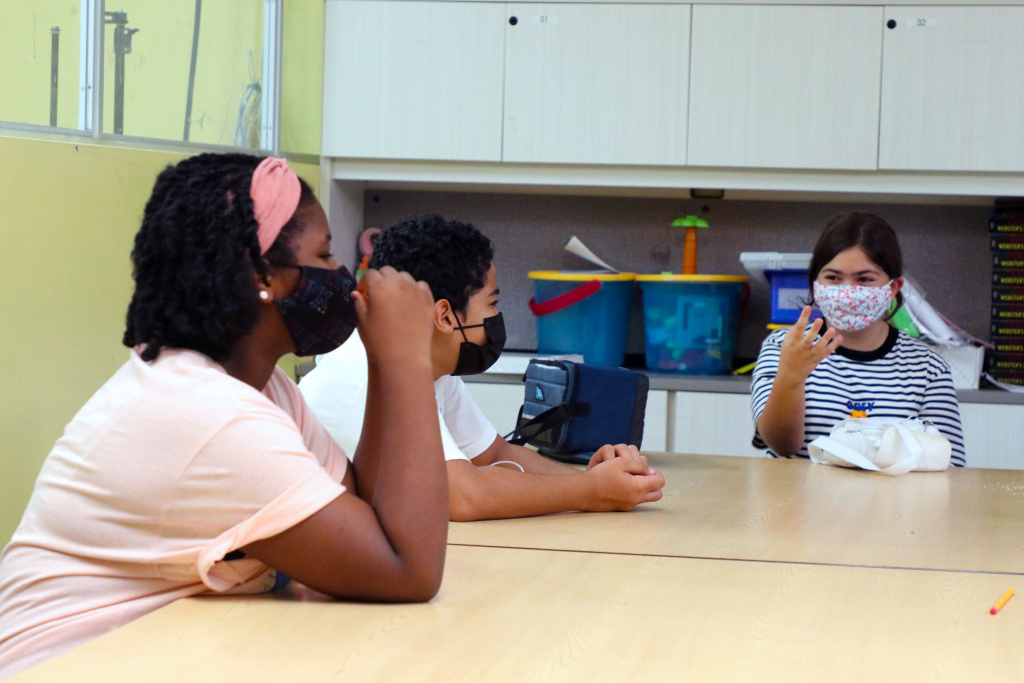
Youth Council members—there are currently eight—are encouraged to discuss their goals and are then placed on a developmental path to ensure progression toward those goals. This is possible because of a concerted effort across HFH. Chapman constantly relays information about students to staff members, so that they are aware when a donation or opportunity comes up that is pertinent to that student’s needs.
Chrystel, 15, a student at Saratoga, has shown a proclivity for fashion and has been attending a modeling workshop in Manhattan. This was arranged by a staff member connected to the modeling agency who was aware of Chrystel’s interests. For Alenell, 12, who is both skilled in and passionate about music, staff have better equipped her for her artistic endeavors by providing her with a keyboard instrument that was donated to the afterschool program. David, 13, who has proven to be an ardent public speaker, has been mentored by students from St. John’s University, who have helped him hone his presentation skills. David was also part of a group that recently observed the power and social impact of having a collective voice. He and several Youth Council members attended a dinner event sponsored by ABIS (Advancement of Blacks in Sports), an organization founded to “seek equal rights and fair treatment of Black people by examining current institutional policies and practices in an effort to promote racial, social, and economic justice.”
“The ABIS event showed what I could get to in public speaking,” says David. “That I could [speak] in front of 100, 200, or even 300 people.”
Chapman is working with the students to instill in them the sense that with their talents comes a level of responsibility and purpose. Older members of the Youth Council mentor the younger participants, who in turn practice these same leadership skills.
“[In the Youth Council], we discuss how to be a good leader in front of the kids,” says Alenell. “They watch us in everything we do, so they will copy our self-control and respect.”
Youth Council members are increasingly turning their attention to community building, which they practice by assisting in developing new programs and events for the afterschool program.
The Saratoga Financial Credit Union was recently created to teach financial literacy and promote leadership, kindness, and integrity. Youth earn “Rec Bucks” by demonstrating positive behaviors such as assisting a classmate, valuing other people’s opinions, and illustrating a willingness to do what is best for everyone. With the earned currency, students can purchase games and toys from the “Rec Bucks” store, managed by Alenell.
According to Chapman, the credit union has also been teaching the students money management and budgeting skills and has been propelling Alenell to new levels of responsibility.
“It teaches Alenell, and those who help manage the store, different things in terms of management,” Chapman explains. “She analyzes the product in the ‘warehouse,’ and when she sees a need for more product, she acts upon it.”
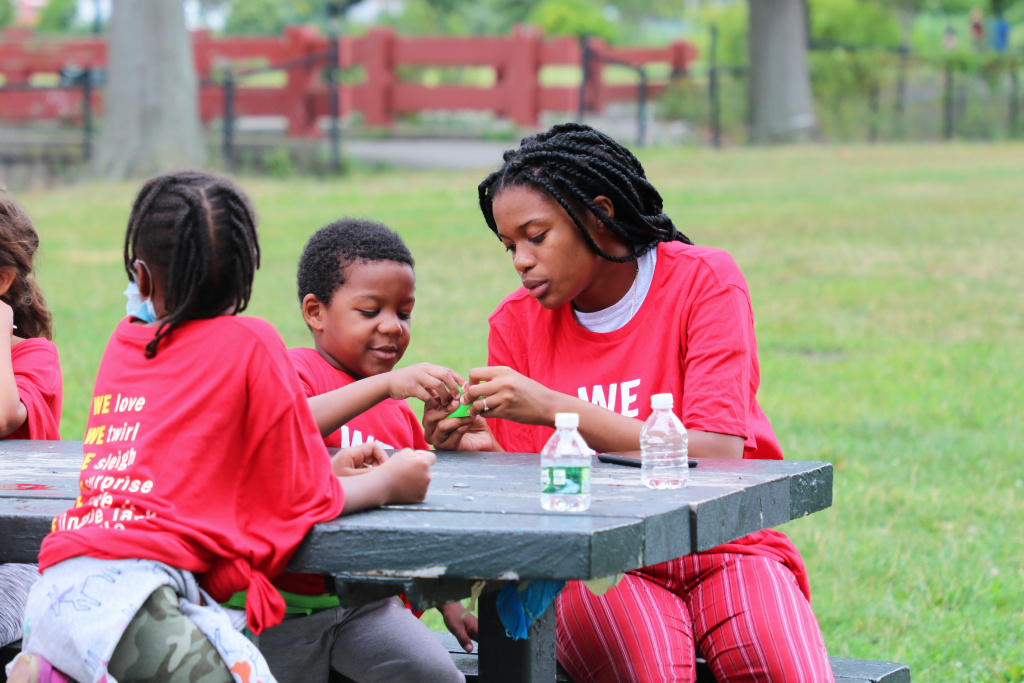
Chrystel describes how new program ideas are born: “When we want to propose something new, first we talk together as youth, and then we talk to Mr. Chapman, and we decide all together.”
One such idea is the Student in Training (SIT) program, which stemmed from one student’s desire to help serve dinner to the students in the afterschool program. As more students volunteered, this blossomed into a two-month initiative where students learn leadership through service. It is an opportunity for them to learn entry-level food management, food delivery, and the elements of creating a positive atmosphere—all centered around serving food.
Since Saratoga’s afterschool program is not constrained by rigid curriculum, this freedom allows for more “skills-based learning,” where children gain valuable life experience through programs such as SIT.
“When students have a voice in shaping the activities their afterschool programs offer, their engagement can deepen as they gain important leadership, organizational, and collaboration skills,” says the Afterschool Alliance’s Grant.
The students in the Youth Council are leaders in conversations about Saratoga afterschool, even when it comes to funding for their new Teen Lounge. They conducted a presentation for longtime HFH collaborator KidCare, outlining their proposal for what the space should be: a place where students can relax and find happiness, whether through the room itself or with each other. They discussed how their dream Teen Lounge would incorporate a bit of everyone’s personal interests in the form of a multimedia room featuring gaming consoles, musical instruments, and arcade games.
KidCare Founder Jonathan Dorfman is looking forward to working with the Youth Council on a regular basis. “The kids showed a great amount of confidence during the presentation,” Dorfman says. “We are so impressed that they take it upon themselves to be leaders for their peers.”
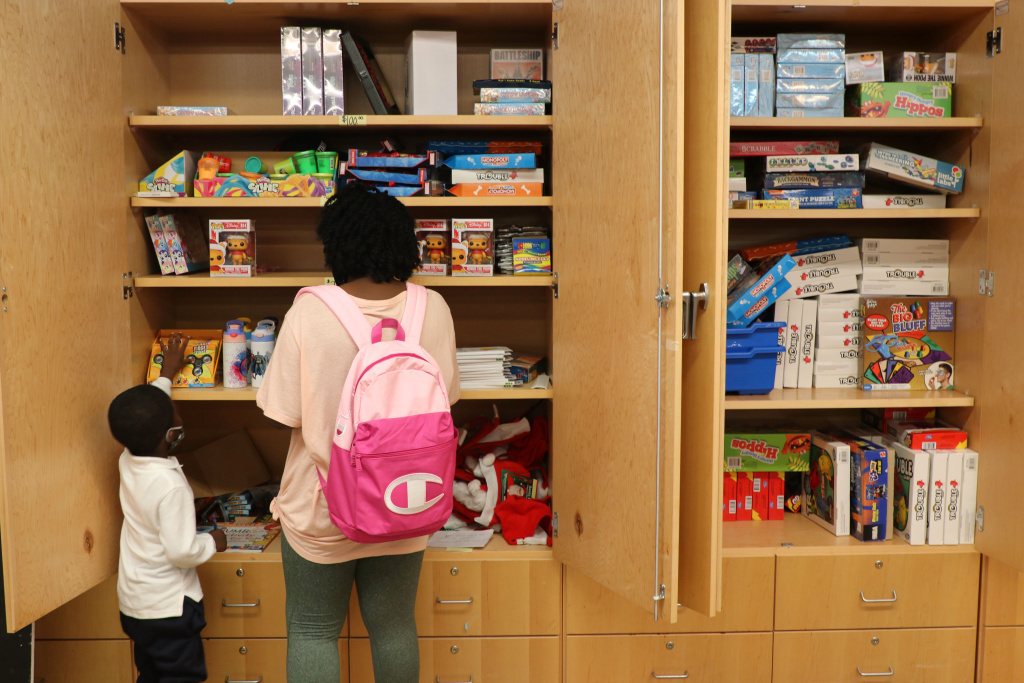
The students focused on operational planning and budgeting for the Teen Lounge project. The numerous life skills they were able to gain—from accountability to compromise—could not have come from a textbook or standard academic experience.
While the Youth Council is currently focused on programming, Chapman is starting to introduce Council members to deeper discussions about public policy. The perfect impetus for these conversations presented itself by way of the NYC mayoral election. Students presented to each other the advice they would offer candidates for New York City Mayor—from more housing to access to youth jobs and space for basketball, and Chapman went so far as to hold a faux press conference, where, acting as mayor, each fielded questions regarding their proposed policies.
Watch the video below to see their responses when asked what actions they would take if elected mayor of New York City.
Discussing public policy has offered students the opportunity to explore the nuances of life in a transitional residence. Thirteen-year-old Youth Council member Joshua has attributed his improved communication skills to living at Saratoga, since it is necessary to communicate with more people in his current community than if he lived elsewhere.
“I feel like this is just something to look back on when I eventually succeed,” says Joshua. “To look back on how I wasn’t in the best situation, but I was able to pull through and succeed.”
It is critical for the afterschool program to be a safe space—providing a place where youth experiencing homelessness can connect with peers who are in similar situations and facing some of the same emotions. This opportunity to share experiences and build relationships outside of school helps students develop communication skills, make friends more easily, become more cooperative, and fight less.1
Moving into the 2021–22 academic year, the Youth Council aims to expand their community building outside of Saratoga. They would ideally like to plan a “Youth Summit” for children at the three HFH family residences in the Bronx and eventually include other shelters for families with children in New York City. They plan to give a tutorial to other youth experiencing homelessness on how they can organize a space to grow individually and collectively in the form of their own Youth Councils.
Hannah Immerman, Senior Programs Associate at HFH, has high hopes for the expansion of the Youth Council to the Bronx HFH family residences.
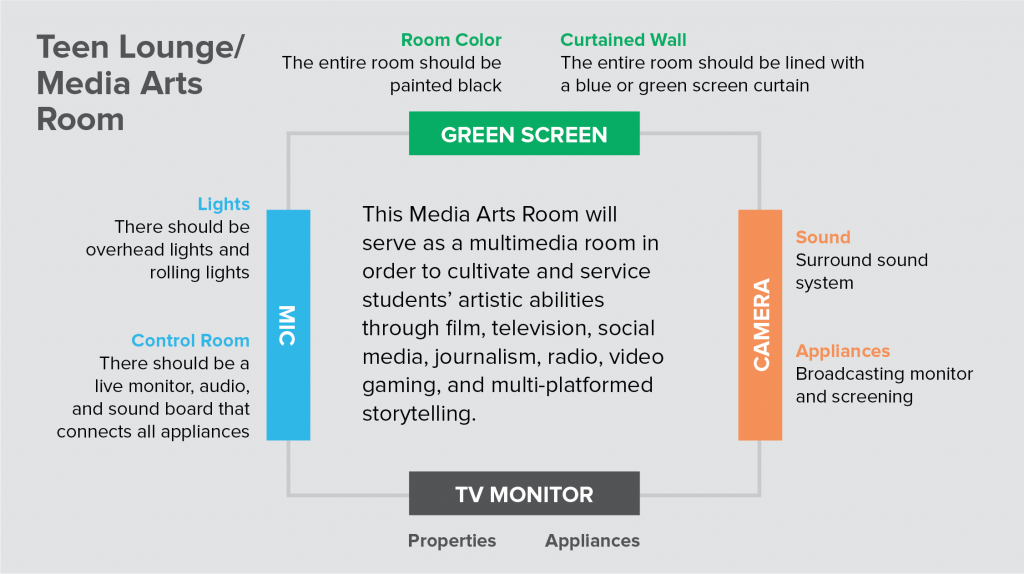
“The Youth Council centers the youth as leaders and provides a platform for the participants to shape their afterschool program and connect with their peers in meaningful ways,” Immerman says. “Our goal is to replicate this model at our other HFH sites so that more youth can drive the development of their afterschool programs.”
David summed up the benefits of the Youth Council and the importance of representation.
“Overall, it’s good to have a voice as a youth, because most of the time, our community is based off adults’ behavior and how the adults are. It’s good that we can represent ourselves.”
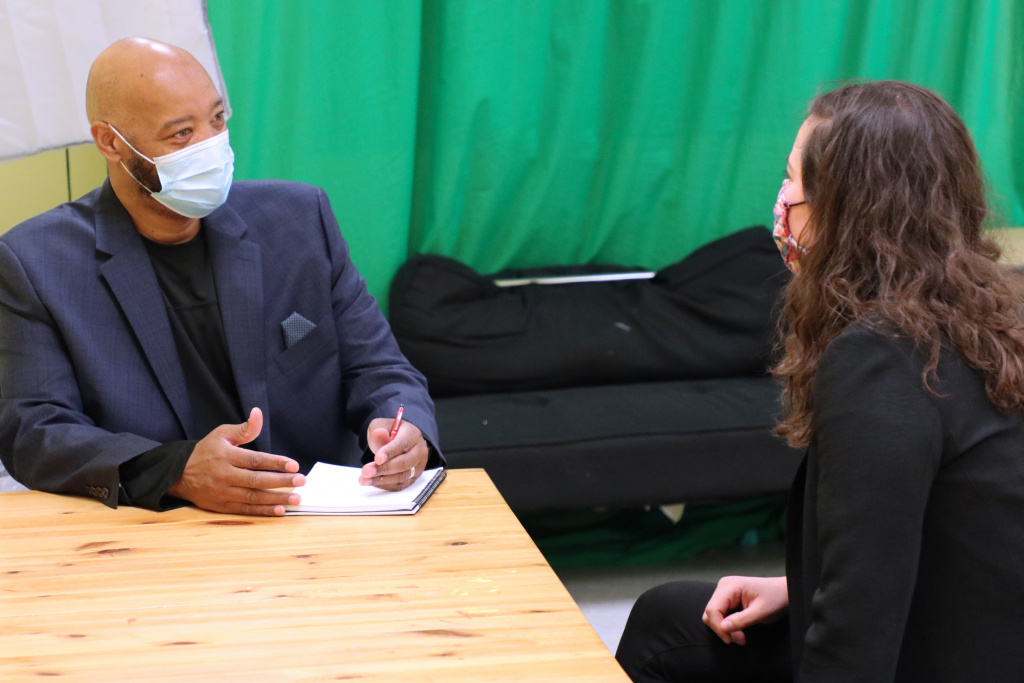
Saratoga Family Residence was featured during the 2020 Beyond Housing conference. Chapman served on the “Putting Children First in Programming” panel alongside Sara Steward of Homefront, Inc. and Jaymes Sime, then of MICHA House, where they discussed the importance of providing access to robust programming for children—birth through college—while temporarily living in shelter. They explored programming options and funding to give kids, and their parents, access to quality pre-K, sports teams, on-site art therapy, and much more.
Mary Cummings is a senior communications associate at Homes for the Homeless. Michael Chapman is director of Afterschool and Recreation at HFH’s Saratoga Family Residence, a 255-unit family shelter in the Jamaica, Queens, neighborhood of NYC. Max Rein is a policy assistant at Homes for the Homeless.
How to Connect:
Mary Cummings / MCummings@HFHnyc.org
Max Rein / MRein@HFHnyc.org
Michael Chapman / MChapman@HFHnyc.org
HFHNYC.org
‘HOUSING IS HEALTH’: Overcrowding, COVID-19, and Evictions in NYC’s Immigrant Neighborhoods
By Sara Herschander
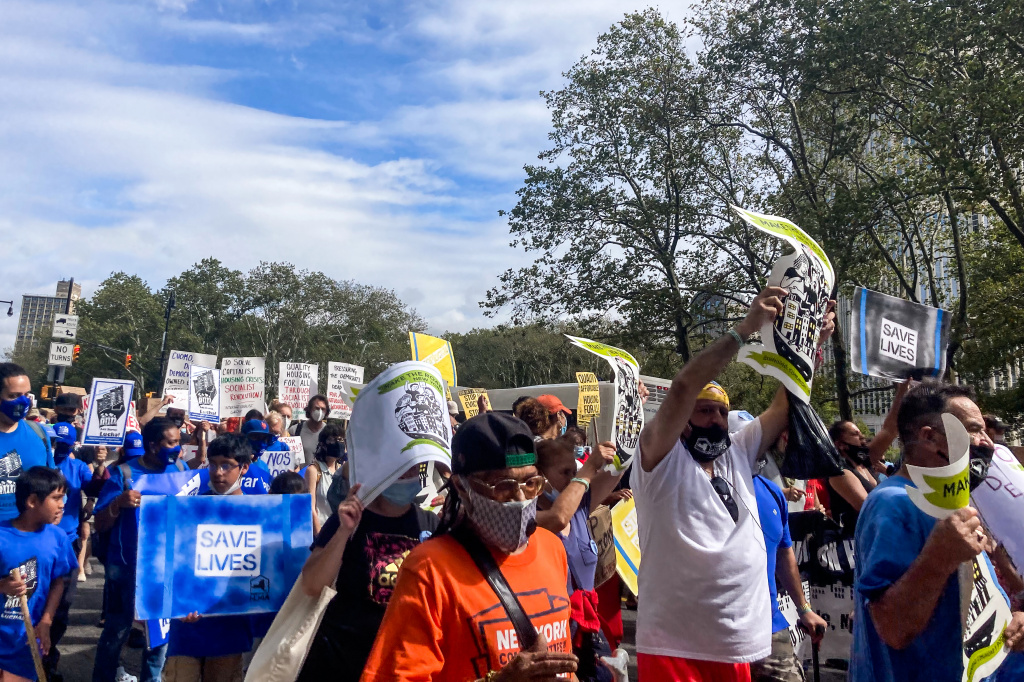
Adelia Farciert was away from home when her sister called around lunchtime: “Did you finish work yet? There’s a fire in the building—they’re evacuating everyone.”
Farciert, 50, who is originally from Puebla, Mexico, rushed home from her job as a housecleaner. The bus skipped her street, by then engulfed in black smoke. It was a chilly day in April 2021, and when Farciert finally got off the bus, she passed by firefighters and fellow tenants, some shivering in pajamas.
“In that moment,” she recalls, “you don’t think of anything at all.”
Farciert and her neighbors had grown closer over the course of the COVID-19 pandemic, which had hit families in the two-building, 133-apartment complex hard when cases first exploded in New York City a year prior. The largely immigrant neighborhood had become a hotbed for infection, killing three building residents and leaving many undocumented and mixed-status families, whose members might have differing immigration statuses, without access to government relief. Still, they socialized on the building’s adjacent “Open Street,” on 34th Avenue in Jackson Heights, Queens—part of a citywide initiative launched as a response to the pandemic. The Open Street afforded families, many of whom lived in overcrowded apartments, with more than one person per room to save on rent, a welcome breath of fresh air.
Until crisis struck again. The devastating eight-alarm fire sent residents scrambling out of their six-story, rent-stabilized building. Rent stabilization, which applies to around one million apartments in New York City, prevents landlords from implementing sharp increases on rent and preserves tenants’ right to renew their leases. The NYC Rent Guidelines Board, a nine-member panel appointed by the mayor, determines the level of rent increase permitted in rent-stabilized apartments each year. The fire injured 21 people, displaced more than 200 residents, and scattered a tight-knit community into friends’ and families’ homes or emergency housing in hotels run by the city’s Department of Housing Preservation and Development (HPD) throughout the city. By August 2021, over 100 residents, including Farciert and her 11-year-old son, remained housing unstable, fighting month-to-month to remain in city-sponsored hotel rooms, as officials attempted to relocate them to homeless shelters run by HPD. While NYC’s Department of Homeless Services (DHS) provides housing services to New Yorkers experiencing homelessness, HPD is the city agency tasked with preserving affordable housing and providing emergency housing to households displaced by fires and city-issued vacate orders. Yet, as residents have decried, there are no HPD shelters in Queens, which is New York City’s largest borough by area and its second most populous, and finding new affordable housing in their neighborhood has become all but impossible.
“Had people just gone to DHS [NYC Department of Homeless Services] intake, they probably could have ended up at a shelter 10 blocks from home,” says Andrew Solokof Diaz, co-president of the 89th Street Tenants Association, a group that has advocated for residents of the two buildings, which are located at the intersection of 34th Avenue and 89th Street.
In neighborhoods like Jackson Heights, where residents are predominantly foreign-born, community members have been sounding the alarm for years over rising rents, rampant overcrowding, gentrification, and a dwindling stock of affordable housing. When the pandemic arrived, these pre-existing housing conditions led to tragedy, with residents suffering from disproportionate rates of COVID-19 infection, hospitalization, and death. In the economic and housing crisis that has followed, residents have once again found themselves on the brink.
“The rents in those two buildings were some of the lowest in Jackson Heights,” says Solokof Diaz. “This fire was a major shot in the gut to those working to prevent displacement in the area.”
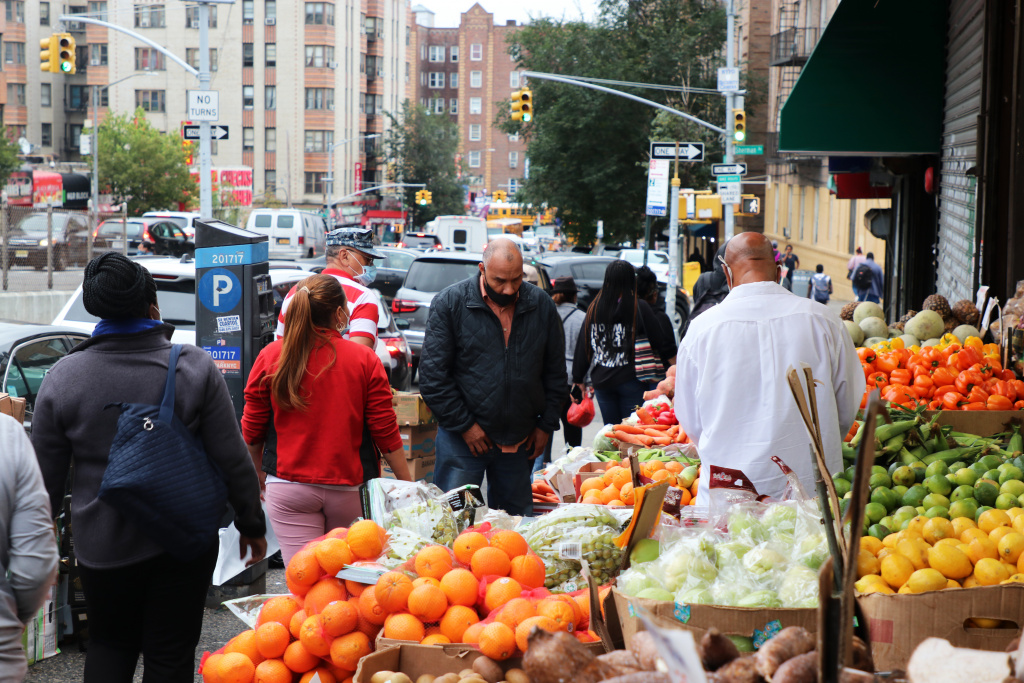
“We either eat or we pay rent,” says Bárbara, a single mother and tenant in Sunset Park, Brooklyn, whose landlord has threatened to kick her and her family out of their apartment, despite national and state eviction moratoriums. A national eviction moratorium declared by Congress was in effect for most tenants from March 2020 to June 2020, after which the Center for Disease Control and Prevention continued to issue its own national moratoriums until the Supreme Court struck them down in August 2021. In New York, tenants have been protected by some form of statewide eviction moratorium since March 2020, with its most recent iteration protecting most tenants until January 2022.
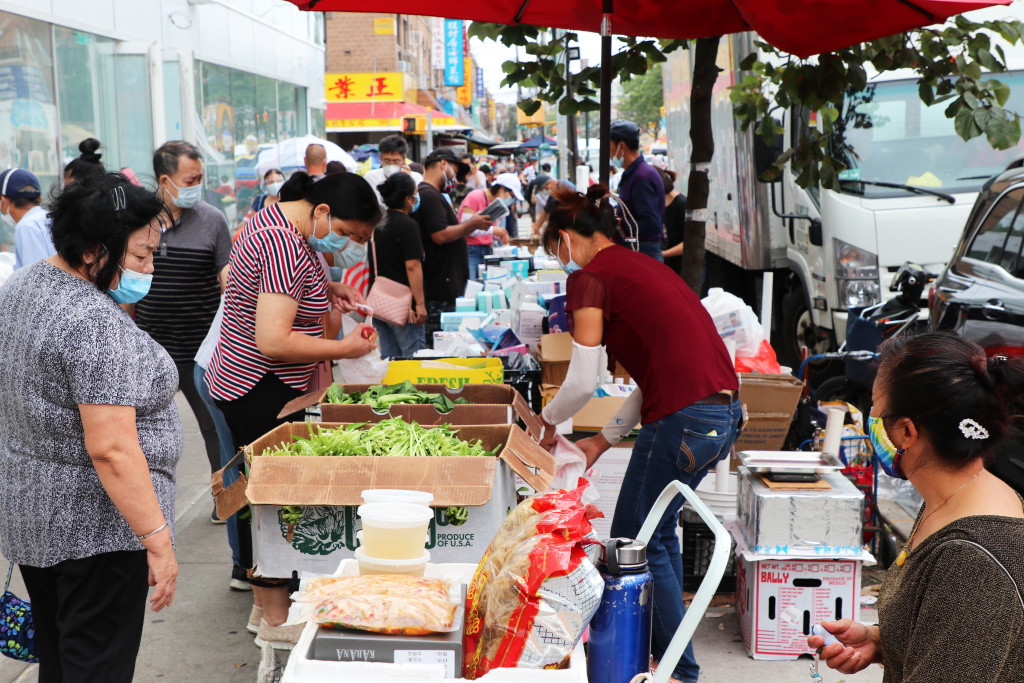
The pandemic, Bárbara says, has forced her and other women to work “more hours for less pay” to afford rent.
Yet, it’s still not enough.
When neighborhoods gentrify, longtime residents often find themselves at a crossroads—unable to match the area’s rising rents, they’re displaced into new neighborhoods or the shelter system. Or, as is often the case for immigrants, who may be reluctant to use city services or leave a community where they speak the language, the only solution may be overcrowding, which allows multiple families to combine incomes to pay rent on just one unit.
After the fire, in the midst of uncertainty, an aunt offered Farciert a space in her home. Yet that aunt had already offered a place to sleep to one of Farciert’s other aunts, one of several members of her extended family also displaced by the fire. “We couldn’t all be there, piled up together,” Farciert reasoned.
Instead, she and her son accepted an offer from HPD for a hotel room near John F. Kennedy Airport. From the hotel, it now takes Farciert two hours to travel to her cleaning clients in Brooklyn. It takes her son over an hour to get to his middle school in Jackson Heights, which had been only four blocks from their old home. The move was meant to be temporary, as the agency attempted to rehouse families, but Farciert was still there in August 2021, four months after she was first displaced.
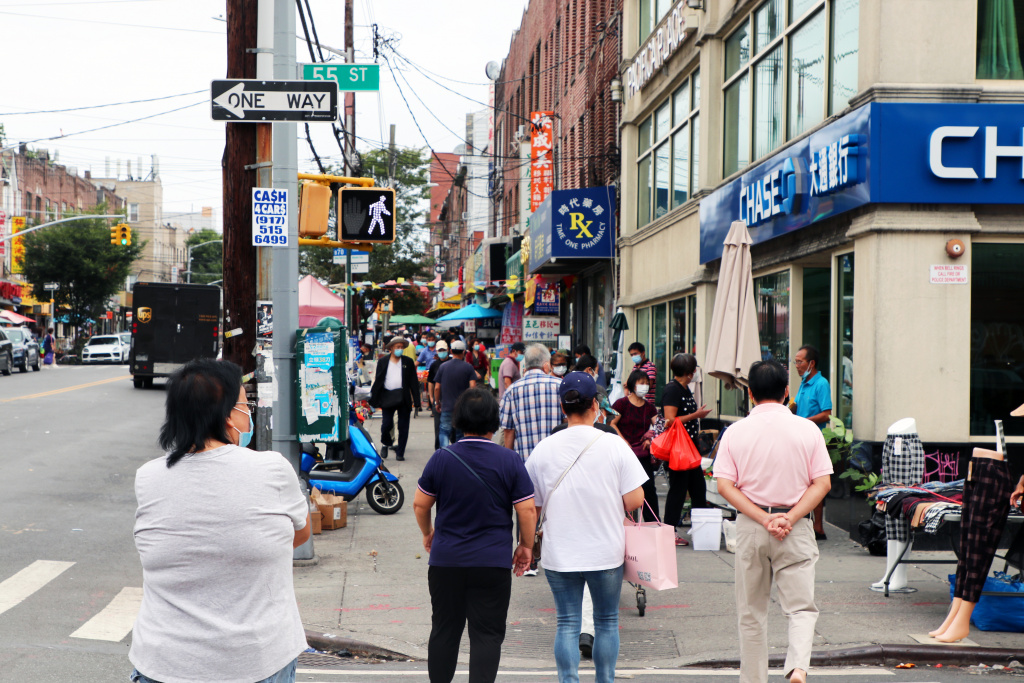
HPD has offered three options to displaced tenants: affordable housing, defined as costing roughly one-third of a household’s income, in the Bronx or South Queens, or first dibs on a pricey new market-rate apartment complex in Jackson Heights that Solokof Diaz called a “giant gentrifying tower.” According to a meeting in which HPD presented housing options for the displaced tenants, a two-bedroom apartment in the newly constructed Jackson Heights complex would cost $2,849 per month. In contrast, rent for a two-bedroom apartment in Far Rockaway, where one of the affordable complexes is located, would be capped at $1,437 per month.
That means the price of moving back to Jackson Heights is prohibitive for people like Farciert, who’s also found excessive documentation requirements, such as paystubs, bank statements, photo IDs, and other records—which many tenants lost in the fire—to be a barrier to housing in the community.
“If they’re checking your credit score and your status, it’s better to just forget about it,” says Farciert, whose family first moved into the apartment complex 23 years prior, at the height of Jackson Heights’ transformation into a haven for multiethnic immigrant families. “I’m just going to wait to see what my solution here can be,” she says.
She’s not the only one struggling to stay in the neighborhood.
“The communities we serve have been pushed out,” says Annetta Seecharran, Executive director of Chhaya CDC, which offers services to South Asian and Indo-Caribbean immigrant communities in Jackson Heights, and, increasingly, throughout the borough, as residents have left the neighborhood in response to gentrification.
In the Bangladeshi community concentrated in Central Queens, 42 percent of households are overcrowded, compared with 9 percent in the city overall. The neighborhoods of Elmhurst and Corona in Central Queens are the most overcrowded in the city, with 11.3 percent of households severely overcrowded and more than 1.5 people per room, followed closely by Jackson Heights at 10.2 percent. Overcrowding, along with other poor housing conditions, has been a major source of COVID-19 contagion.
“If one member of the household gets infected, because they’re an essential worker, the rest of the household will immediately catch the virus,” says Seecharran, referencing the pandemic’s devastation of overcrowded communities.
According to researchers at Weill Cornell Medical College, severe cases of COVID-19 were 67 percent more likely to occur in overcrowded neighborhoods, with multigenerational households at even greater risk. As of August 2021, in the majority Latino immigrant neighborhood of Corona, Queens, one out of every 183 residents had died of COVID-19. In Manhattan’s majority white and high-income Financial District, only one out of every 3,381 residents had died.
“There were so many traumas, and we all became sick,” recalls Leonila, a mother in Los Sures on the south side of Williamsburg, Brooklyn, a Latino neighborhood greatly impacted by gentrification in recent decades. “It’s been so much for me,” she continues. “I think about how it’s affected my children.”
At a protest and civil action in August 2021, advocates and tenants from throughout the city marched while carrying moving boxes and spray-painted suitcases, meant to symbolize their demands for comprehensive rent relief and eviction prevention for New York City tenants.
“They just keep raising and raising the rent,” says Jorge, a tenant in Woodside, a Queens neighborhood adjacent to Jackson Heights. “We don’t want them to evict us from our homes.”
Overcrowding doesn’t occur in a vacuum and can be considered both a symptom of deeper housing and health crises and a warning sign for evictions, displacement, and, in some cases, homelessness. According to ICPH, more than one-third of families with children who entered the NYC shelter system in 2018 did so because of an eviction or overcrowding.
“Once you’re evicted, you are far more likely to be evicted again,” says Cea Weaver, campaigns coordinator for Housing Justice for All, a statewide advocacy group that organized the anti-eviction rally in August. “You can’t address homelessness without addressing evictions.”
In April 2021, the Association for Neighborhood & Housing Development (ANHD) released a report warning that landlords were filing evictions at rates 3.6 times higher in the zip codes hardest hit by the COVID-19 pandemic, where 68.2 percent of residents are people of color. Despite national and state eviction moratoriums, landlords have still been able to file for eviction with certain limitations and tenant protections, and most housing court cases have been on hold since March 2020. Exceptions to the eviction moratorium have slowly grown since the pandemic began, and for some immigrant tenants, who are more likely to live in informal and unregulated housing or illegal conversions, the protections have never shielded them from eviction. As of press time, the NYS eviction moratorium was set to expire on January 15, 2022.
“It’s a cycle in which harms are perpetuated by other harms,” says Lucy Block, research and policy associate at ANHD. “Where people of color live is where people are dying from COVID-19 and where people are getting evicted.”
Even as COVID-19 cases skyrocketed, rents continued to rise in Central Queens and other gentrifying neighborhoods. In contrast, many of Manhattan’s wealthiest enclaves experienced a significant, if temporary, drop in rent prices, as office buildings closed and residents fled the city. Central Queens, followed by the Northwest Bronx and Sunset Park, is also home to the greatest share of residents employed in the restaurant, hospitality, and retail industries, which experienced the highest rate of layoffs during the pandemic’s early lockdowns.
“At any moment, they can throw us onto the streets,” says María, a tenant and member of Community Action for Safe Apartments in the Bronx. “We have a right to housing until we get our jobs back, and until we have a normal life.”
In September 2021, New York State enacted a new eviction moratorium, built to protect tenants until the beginning of 2022. The announcement came as the state’s rental assistance program—meant to protect tenants regardless of immigration status as the federal moratorium expires—has been off to a slow start. The program provides rental assistance to low and moderate-income households who have experienced financial hardship as a result of the COVID-19 pandemic. Less than 6 percent of applicants had received payments from the state as of August 2021, and only 15 percent of low-income rental households had applied. Many programs have onerous requirements, including proof of income and residency, that act as a barrier for tenants, even if they are eligible, and if the state fails to distribute rental assistance by a September 30, 2020 deadline, the unspent funds may be returned to the national government.
With many undocumented New Yorkers ineligible for unemployment insurance, stimulus payments, and food assistance, it’s been all but impossible for residents to keep up with living expenses. In August 2021, New York State opened applications for its Excluded Workers Fund to help undocumented workers and others excluded from government relief. Still, Alex Fennell, senior housing organizer for ANHD, says that the resulting patchwork of rent relief and eviction moratoria policies has fallen short of protecting the city’s most vulnerable tenants.
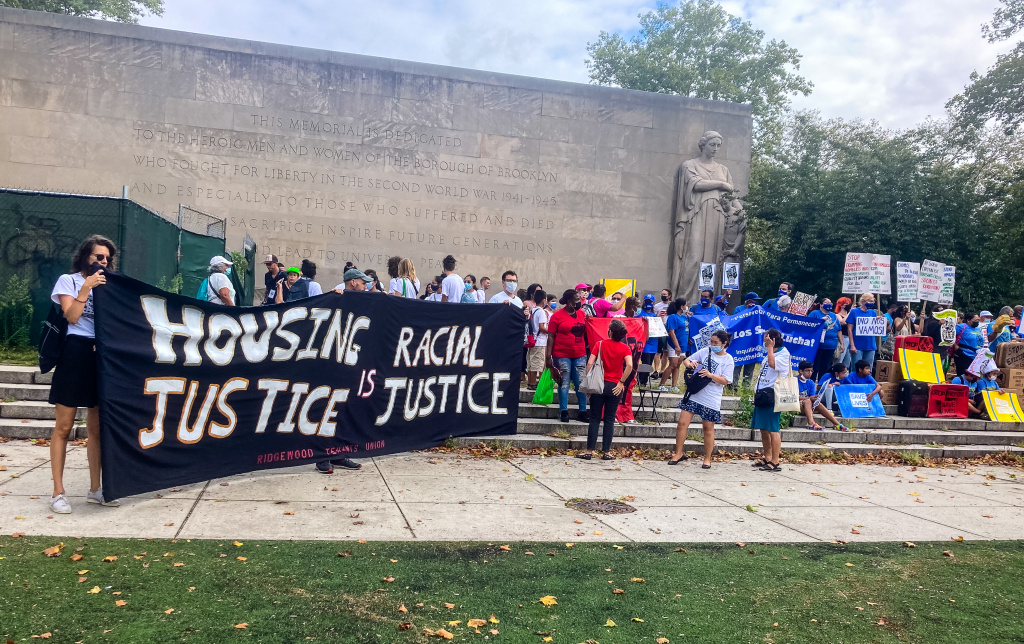
“Every layer of additional documentation and every layer of technical difficulty reduces the number of our most vulnerable tenants who are going to be able to continue with the process,” Fennell says, noting that New York’s rent relief program requires a high degree of digital literacy, including the use of two-factor authentication, which requires users to provide a verification code sent to a trusted device, like a cell phone or laptop, to access their account.
What’s more, advocates like Jennifer Hernandez, lead organizer for Make the Road New York, fear that the city’s looming eviction crisis will make it even harder to fight the ongoing COVID-19 crisis, including new variants: “The only way that we can survive Delta is if we make sure that people are able to stay in their homes,” she asserts.
According to the research group National Equity Atlas, over 800,000 households in New York State are behind on rent. Collectively, they owe over $3 billion in rent debt, and the majority are low-income people of color. As of August 2021, more than 66,000 eviction cases had already been filed in New York since the pandemic began. If adequate eviction prevention measures fail to pass or come to fruition, the results to families’ housing stability could be catastrophic.
“We’ve always paid our rent, but we’re in a pandemic now,” says María. “We’re organizing to be able to live with dignity.”
Sara Herschander is a freelance journalist and editor with a master’s in bilingual journalism from the Craig Newmark Graduate School of Journalism at CUNY. She reports in English and Spanish on labor, immigration, and housing in New York City.
How to Connect:
Resources:
Watch this video for a deeper look into this topic.
‘LA VIVIENDA ES SALUD’: hacinamiento, COVID-19 y desalojos en los barrios de inmigrantes de Nueva York
Por Sara Herschander
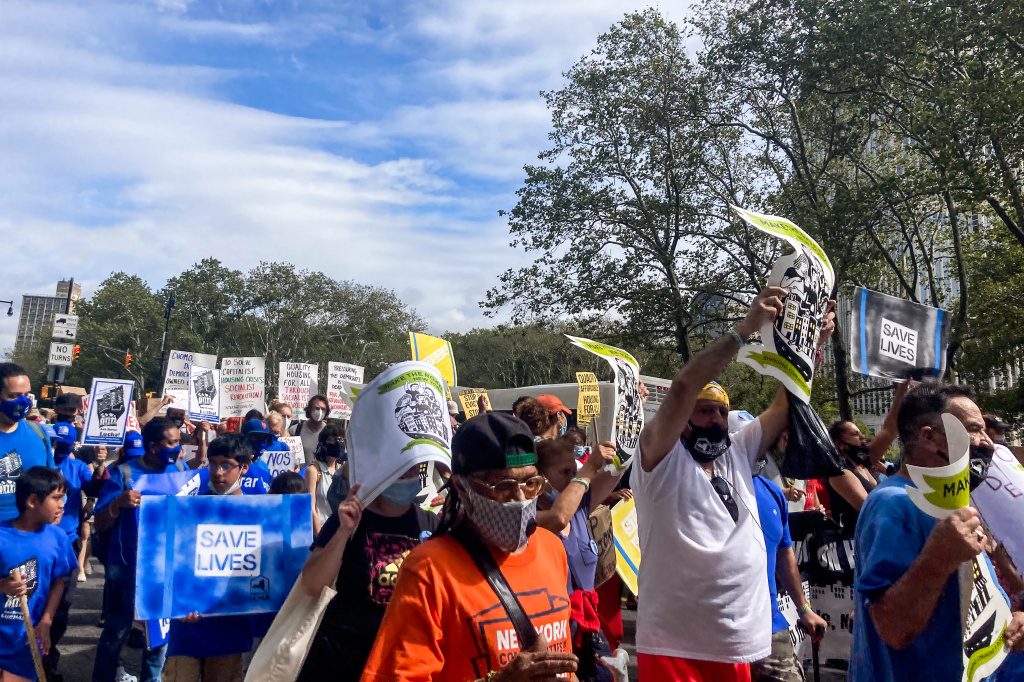
Adelia Farciert se encontraba lejos de su casa cuando su hermana la llamó a la hora del almuerzo: “¿Ya terminaste de trabajar? Hay un incendio en el edificio y están evacuando a todos”, le dijo.
Farciert, de 50 años, quien es originaria de Puebla, México, corrió de inmediato a su casa desde dónde estaba haciendo un trabajo de limpieza.
El autobús que tomó evitóla calle donde estaba ubicada su vivienda, allí solo se veía humo negro. Era un día frío en abril de 2021 y cuando Farciert finalmente se bajó del autobús, se cruzó con bomberos y sus vecinos, algunos temblando en pijama.
“En ese momento no se te ocurre nada en absoluto”, recordó.
Farciert y sus vecinos se habían acercado más durante la pandemia, que afectó drásticamente a las familias en el complejo de dos edificios de 133 apartamentos, cuando los casos de Coronavirus se conocieron por primera vez en la ciudad de Nueva York, hace más de un año.
El barrio, que es en su mayoría habitado por la comunidad inmigrante, se había convertido en un epicentro de infección. Tres residentes de los edificios murieron y muchas familias indocumentadas y de estatus mixto se enfrentaron a distintos retos económicos por no tener acceso a la ayuda del Gobierno.
A pesar de la crisis, los vecinos salían a socializar en la calle que fue cerrada al tráfico y habilitada exclusivamente para los transeúntes y que ubicaba adyacente al edificio en la avenida 34 en Jackson Heights, Queens. Este programa también conocido como calles abiertas hace parte de una iniciativa a nivel ciudadano lanzada como respuesta a la pandemia. El espacio ofrecía a las familias, muchas de las cuales vivían en apartamentos superpoblados, con más de una persona por habitación para ahorrar en alquiler, un agradable soplo de aire fresco.
Cuando se reponían de la pandemia, la crisis los golpeó de nuevo. El devastador incendio de ocho alarmas obligó a a los residentes a salir de su edificio de seis pisos de renta estabilizada.
La estabilización del alquiler, que se aplica a alrededor de un millón de apartamentos en la ciudad de Nueva York, impide a los propietarios implementar aumentos drásticos en el valor de la renta y preserva el derecho de los inquilinos a renovar sus contratos de arrendamiento. La Junta de Reglas de alquiler, un panel de nueve miembros nombrados por el alcalde, determina el nivel de aumento del arriendo permitido en los apartamentos de renta estabilizada cada año.
El fuego dejó heridas a 21 personas, desplazó a más de 200 residentes, y dispersó una comunidad muy unida en casas de amigos, familias, y alojamientos de emergencia en hoteles y albergues familiares patrocinados por el Departamento de Conservación y Desarrollo de la Vivienda (HPD, en inglés). En agosto de 2021, más de 100 residentes, entre ellos Farciert y su hijo de 11 años, seguían teniendo viviendas inestables, luchando mes a mes para permanecer en habitaciones de hotel patrocinadas por HPD, mientras las autoridades intentaban reubicarlos en otras viviendas de emergencia.
El Departamento de Servicios para las Personas sin Hogar (DHS, en inglés) de Nueva York ofrece servicios de vivienda a los neoyorquinos que experimentan la falta de un hogar, y el HPD se encarga de de preservar la vivienda asequible y proporcionar vivienda de emergencia a las familias desplazadas por incendios y órdenes de desalojo de la ciudad. Sin embargo, como los residentes han denunciado, el HPD no les ha ofrecido ninguna otra opción de vivienda de emergencia en Queens, que es el distrito más grande de la ciudad de Nueva York por área y el segundo más poblado. Encontrar nuevas viviendas asequibles en su barrio se ha vuelto casi imposible.
“Si la gente hubiera ido al DHS, probablemente podrían haber terminado en un refugio a 10 cuadras de casa”, dijo Andrew Solokof Díaz, co-presidente de la Asociación de Inquilinos de la Calle 89, que ha abogado por los residentes de los dos edificios, que se encuentran en la intersección de la Avenida 34 y la Avenida 89.
En vecindarios como Jackson Heights, donde los residentes son predominantemente nacidos en el extranjero, durante años los miembros de la comunidad han estado alarmando a las autoridades por el aumento de los alquileres, el hacinamiento, la gentrificación y mejores oportunidades de vivienda asequibler. Cuando llegó la pandemia, estas condiciones de vivienda preexistentes llevaron a la tragedia, con residentes que sufrierom de tasas desproporcionadas de muerte e infección por COVID-19, hospitalizaciónes y muerte. En la crisis económica y de vivienda que ha seguido, los residentes se han vuelto a encontrar al borde del precipicio.
“Los alquileres en esos dos edificios eran de los más bajos de Jackson Heights. Este fuego fue un gran disparo en el intestino a los que trabajan para evitar el desplazamiento en la zona”, dijo Solokof Díaz.
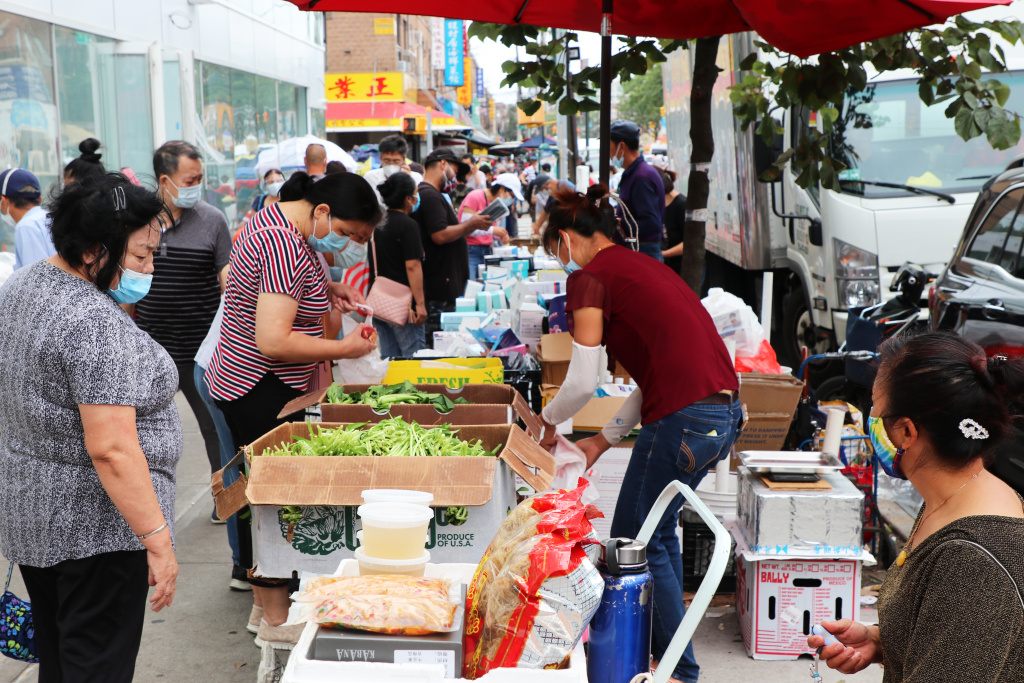
“Comemos o pagamos alquiler”, aseguró Bárbara, madre soltera e inquilina en Sunset Park, Brooklyn, cuyo propietario ha amenazado con echarla a ella y a su familia de su apartamento, a pesar de las moratorias de desalojo nacionales y estatales.
Una moratoria nacional de desalojos declarada por el Congreso estuvo en vigor para la mayoría de los inquilinos desde marzo de 2020 hasta junio de 2020, después de lo cual el Centro para el Control y la Prevención de Enfermedades (CDC, en inglés) continuó emitiendo sus propias moratorias nacionales hasta que la Corte Suprema las anuló en agosto de 2021. En Nueva York, los inquilinos han sido protegidos por una moratoria estatal de desalojos desde marzo de 2020, con su versión más reciente que cobijó a la mayoría de los inquilinos hasta enero de 2022.
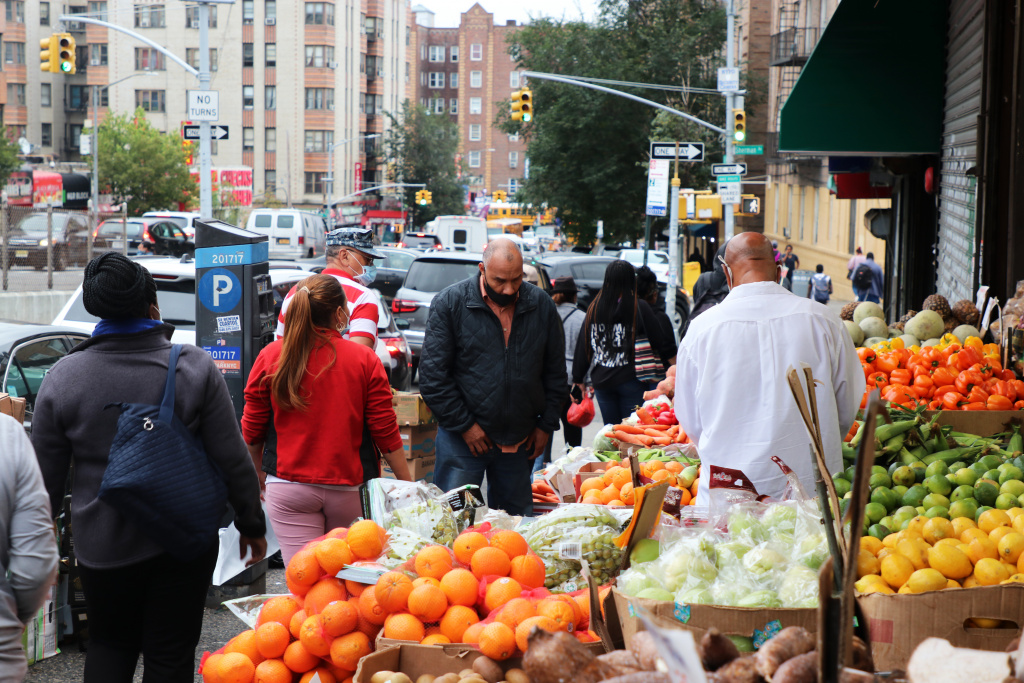
La pandemia, dice Bárbara, la ha obligado a ella y a otras mujeres a trabajar “más horas por menos paga” para pagar el alquiler.
Sin embargo, aún no es suficiente.
Cuando los barrios experimentan la gentrificación, los residentes más antiguos a menudo terminan enfrentándose a la encrucijada de igualar los crecientes aumentos de alquileres en el área y los despazamientos. O, como a menudo ocurre con los inmigrantes, que pueden ser reacios a utilizar los servicios de la ciudad o salir de una comunidad donde hablan el idioma, la única solución puede ser el hacinamiento, que permite a varias familias combinar ingresos para pagar el alquiler en una sola unidad.
Después del incendio, en medio de la incertidumbre, una tía le ofreció a Farciert un espacio en su casa. Sin embargo, esa tía ya había ofrecido un lugar para dormir a una de sus hermanas, uno de varios miembros de su familia que también fueron desplazados por el fuego. “No podíamos estar todos allí, amontonados”, afirmó Farciert.
En cambio, ella y su hijo aceptaron una oferta del HPD para una habitación de hotel cerca del aeropuerto John F. Kennedy. Desde el hotel, Farciert ya tarda dos horas en viajar a las casas de sus clientes de limpieza en Brooklyn. Su hijo tarda más de una hora en llegar a su escuela secundaria en Jackson Heights, que había estado a sólo cuatro cuadras de su antiguo hogar. El traslado estaba destinado a ser temporal, mientras que la agencia intentó realojar a las familias, pero Farciert y su hijo aún estaban allí en agosto de 2021, cuatro meses después de que fueron desplazados.
El HPD ha ofrecido tres opciones a los inquilinos desplazados: vivienda asequible, definida como de un costo aproximado a un tercio de los ingresos de un hogar, en el Bronx o el sur de Queens, o ser primeros en la lista de un nuevo complejo de apartamentos a precio de mercado en Jackson Heights, que Solokof Diaz llamó un “torre gigante de gentrificacin”.
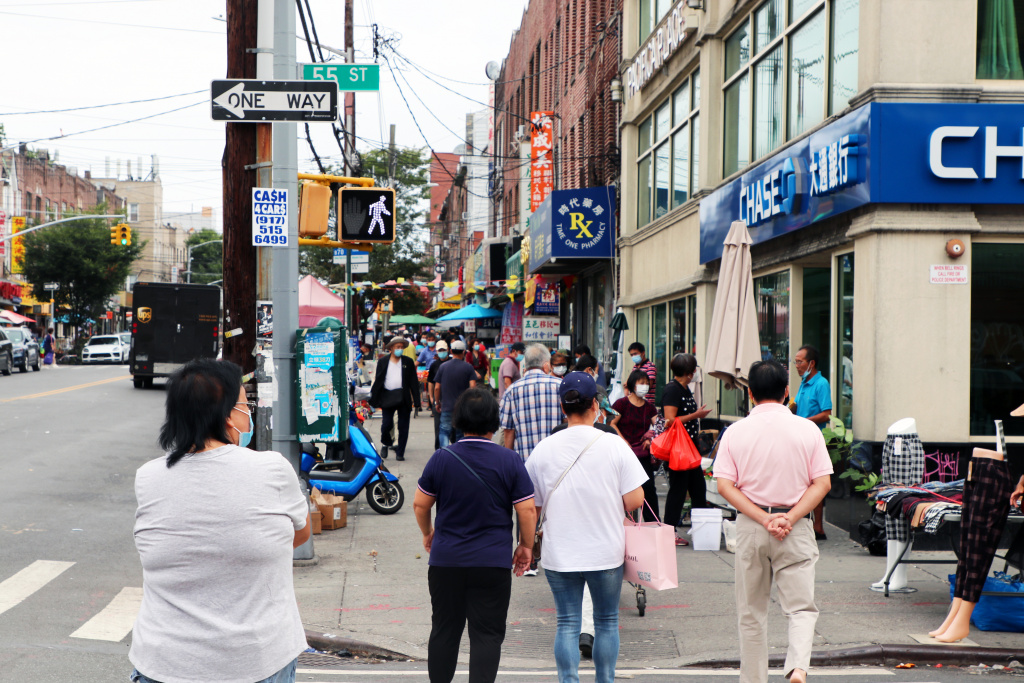
para los inquilinos desplazados, un apartamento de dos dormitorios en el complejo recién construido de Jackson Heights costaría $2,849 por mes. En contraste, el alquiler de un apartamento de dos dormitorios en Far Rockaway, donde se encuentra uno de los complejos asequibles, tendría un límite de $1,437 por mes.
Eso significa que el precio de volver a Jackson Heights es excesivo para personas como Farciert, que también ha enfrentado altos precios en recibos de pago, estados de cuenta bancarias, fotografías para documentos de identidad y otros papeles que muchos inquilinos perdieron en el incendio. Esto se convierte en una barrera para la vivienda en la comunidad.
“Si están revisando tu puntaje de crédito y tu estatus, es mejor olvidarlo”, dijo Farciert, cuya familia se mudó por primera vez al complejo de apartamentos 23 años antrás, en el apogeo de la transformación de Jackson Heights en un refugio para familias inmigrantes multiétnicas.
“Voy a esperar a ver cuál puede ser mi solución”, dijo.
No es la única que lucha por quedarse en el barrio.
“Las comunidades a las que servimos han sido expulsadas”, dijo Annetta Seecharran, directora ejecutiva de Chhaya CDC, que ofrece servicios a las comunidades de inmigrantes de Asia del Sur e Indo-Caribe en Jackson Heights, y cada vez más, en todo el distrito, ya que los residentes han dejado el barrio en respuesta a la gentrificación.
En la comunidad banglades í ubicada en Queens, el 42% de los hogares están hacinados, en comparación con el 9% en la ciudad en general. Los barrios de Elmhurst y Corona en Central Queens son los más hacinados de la ciudad con un 11,3% de los hogares en esta condición, con más de 1,5 personas por habitación, seguido de cerca por Jackson Heights con un 10,2%. El hacinamiento, junto con otras malas condiciones de vivienda, ha sido una fuente importante de contagio de COVID-19.
“Si un miembro de la familia se infecta, porque es un trabajador esencial, el resto de la familia se contagia inmediatamente del virus”, dijo Seecharran, haciendo referencia al riesgo en las comunidades hacinadas por la pandemia .
Según investigadores del Weill Cornell Medical College, los casos graves de COVID-19 tenían un 67% más de probabilidades de ocurrir en vecindarios superpoblados, con hogares multigeneracionales en un riesgo aún mayor. A partir de agosto de 2021, en el barrio de inmigrantes de mayor parte latinos de Corona, Queens, uno de cada 183 residentes ha muerto de COVID-19. En el Distrito Financiero, mayoritariamente blanco y de altos ingresos de Manhattan, sólo uno de cada 3.381 residentes murió.
“Hubo tantos traumas, y todos nos enfermamos”, recordó Leonila, una madre en Los Sures en el lado sur de Williamsburg, Brooklyn, un barrio latino desplazado en gran medida por la gentrificación en las últimas décadas. “Ha sido mucho para mí”, continuó. “Pienso en cómo ha afectado a mis hijos.”
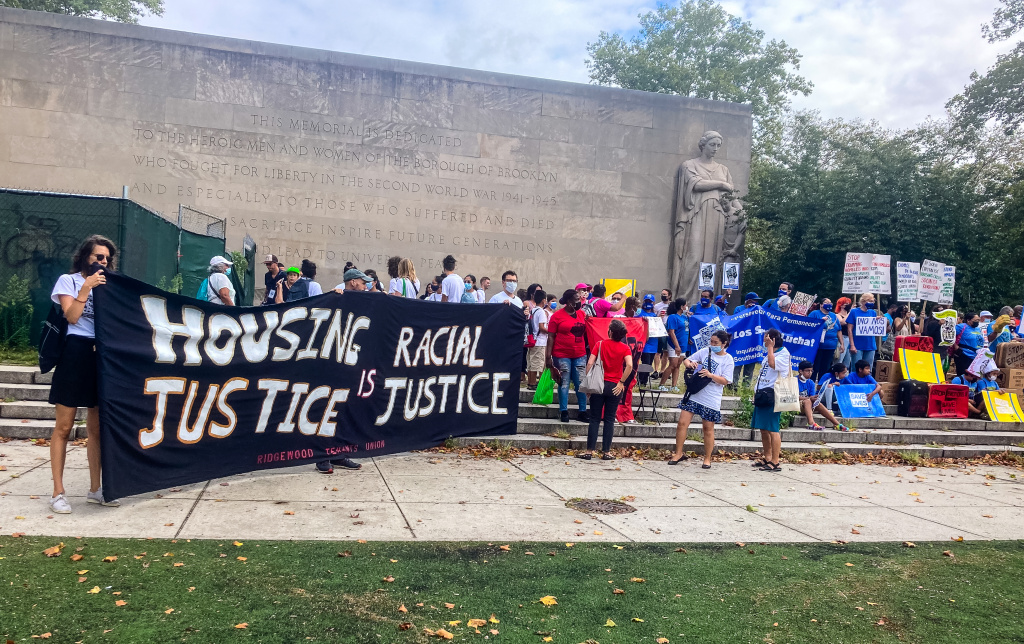
En una protesta y acción civil en agosto de 2021, defensores e inquilinos de toda la ciudad marcharon mientras llevaban cajas móviles y maletas pintadas con aerosol, destinadas a simbolizar sus demandas de alivio integral del alquiler y prevención de desalojos para los inquilinos de la ciudad de Nueva York.
“Siguen aumentando y aumentando el alquiler”, dijo Jorge, un inquilino en Woodside, un barrio de Queens adyacente a Jackson Heights. “No queremos que nos desalojen de nuestras casas.”
El hacinamiento no ocurre en el vacío, y puede considerarse un síntoma de crisis más profundas de vivienda y salud, así como una señal de advertencia para los desalojos, el desplazamiento y, en algunos casos, la falta de vivienda. Según ICPH, más de un tercio de las familias con niños entraron al sistema de albergues de Nueva York debido a un desalojo o hacinamiento en 2018.
“Una vez que eres desalojado, es mucho más probable que vuelvas a ser desalojado”, dijo Cea Weaver, coordinadora de campañas de Housing Justice 4 All, un grupo de defensa a nivel estatal que organizó la manifestación contra el desalojo en agosto. “No se puede abordar la falta de vivienda sin abordar los desalojos.”
En abril de 2021, la Association for Neighborhood & Housing Development (ANHD, en inglés) publicó un informe advirtiendo que los propietarios estaban presentando desalojos a tasas 3.6 veces más altas en los códigos postales más afectados por la pandemia COVID-19, donde los residentes son 68.2% personas de color. A pesar de las moratorias de desalojos nacionales y estatales, los propietarios todavía han podido solicitar el desalojo con ciertas limitaciones y protecciones para los inquilinos, y la mayoría de los casos judiciales de vivienda han estado en suspenso desde marzo de 2020. Las excepciones a la moratoria de desalojos han crecido lentamente desde que comenzó la pandemia, y para algunos inquilinos inmigrantes, que son más propensos a habitar viviendas informales y no reguladas o ilegales, las medidas nunca los han protegido del desalojo.
“Es un ciclo en el que los daños son perpetuados por otros daños”, dijo Lucy Block, investigadora y asociada de políticas de ANHD. “Donde vive la gente de color es donde la gente se está muriendo de COVID-19 y está siendo desalojada.”
Incluso cuando los casos de COVID-19 se dispararon, los alquileres siguieron aumentando en Jackson Heights y otros barrios con gentrificación. En contraste, muchos de los enclaves más ricos de Manhattan experimentaron una caída significativa, aunque temporal, en los precios de alquiler, ya que los edificios de oficinas cerraron y los residentes huyeron de la ciudad. El central de Queens, seguido por noroeste del Bronx y Sunset Park, es también el hogar de la mayor parte de los residentes empleados en las industrias de restaurantes, hostelería y comercio minorista, y que experimentaron la tasa más alta de despidos durante los cierres tempranos de la pandemia.
“En cualquier momento, nos pueden echar a la calle”, dijo María, una inquilina y miembro de Acción Comunitaria por Apartamentos Seguros en el Bronx. “Tenemos derecho a la vivienda hasta que recuperemos nuestro trabajo y hasta que tengamos una vida normal.”
En septiembre de 2021, el estado de Nueva York promulgó una nueva moratoria de desalojos, hecha para proteger a los inquilinos hasta principios del próximo año. El anuncio se produjo cuando el programa de asistencia de alquiler del estado, destinado a proteger a los inquilinos independientemente de su estatus migratorio a medida que expira la moratoria federal, ha tenido un comienzo lento. La iniciativa proporciona asistencia de alquiler a familias de ingresos bajos y moderados que han experimentado dificultades financieras como resultado de la pandemia de COVID-19. Menos del 6% de los solicitantes habían recibido pagos del estado hasta agosto de 2021, y sólo el 15% de los hogares de bajos ingresos habían solicitado. Muchos programas tienen requisitos complejos, incluida la prueba de ingresos y residencia, que actúan como una barrera para los inquilinos, incluso si son elegibles. Si el estado no reparte la asistencia de alquiler dentro de un plazo del 30 de septiembre de 2020, los fondos no gastados pueden ser devueltos al Gobierno nacional.
Con muchos neoyorquinos indocumentados no elegibles para el seguro de desempleo, pagos de estímulo y asistencia alimentaria, ha sido casi imposible para los residentes mantenerse al día con sus gastos. En agosto de 2021, el estado de Nueva York abrió solicitudes para un Fondo de Trabajadores Excluidos destinado a ayudar a los trabajadores indocumentados que no eran protegidos por las ayuda del Gobierno. Sin embargo, Alex Fennell, organizador senior de vivienda de ANHD, dice que el mosaico de políticas del alivio de renta y moratorias de desalojo del estado no ha logrado proteger a los inquilinos más vulnerables de la ciudad.
“Cada capa de documentación adicional y cada capa de dificultad técnica reduce el número de nuestros inquilinos más vulnerables que van a poder continuar con el proceso”, dijo Fennell, señalando que el programa de alivio de alquiler de Nueva York requiere un alto grado de alfabetización digital, incluyendo el uso de la autenticación de dos factores. La identificación de dos factores requiere que los usuarios proporcionen un código de verificación enviado a un dispositivo confiable, como un teléfono celular o un computador portátil, para acceder a su cuenta.
Además, defensores como Jennifer Hernández, organizadora principal de Make the Road New York, temen que la inminente crisis de desalojo de la ciudad hará que sea aún más difícil luchar contra la actual crisis de COVID-19, incluyendo nuevas variantes: “La única forma de sobrevivir a Delta es si nos aseguramos de que la gente pueda quedarse en sus casas.”
Según el grupo de investigación National Equity Atlas, más de 800.000 hogares en el estado de Nueva York están atrasados en el alquiler. Colectivamente, deben más de $3 mil millones en deudas de alquiler, y la mayoría son personas de color de bajos ingresos. Hasta agosto de 2021, más de 66.000 casos de desalojo ya se han presentado en Nueva York desde que comenzó la pandemia. Si las medidas adecuadas de prevención de los desalojos no se adoptan o se materializan, los resultados para la estabilidad de la vivienda de las familias podrían ser catastróficos.
“Siempre hemos pagado el alquiler, pero ahora estamos en una pandemia”, dijo María, miembro de Acción Comunitaria por Apartamentos Seguros. “Nos estamos organizando para poder vivir con dignidad.”
Sara Herschander es periodista independiente y editora con una maestría en periodismo bilingüe de la Escuela de Periodismo Craig Newmark de CUNY. Ella informa en inglés y español sobre trabajo, inmigración y vivienda en la ciudad de Nueva York.
Cómo conectarse:
TIME TO BUILD A BETTER SHELTER-TO-SCHOOL BRIDGE: A Retrospective on the Experiences of NYC Students and Families in Shelter during the Pandemic School Year
By Robyn Schwartz with additional reporting by Linda Bazerjian
Note: Citations and sources for data are included in the PDF version of this document available by clicking Downloads underneath the Table of Contents.
When New York City school buildings closed in March 2020, no one anticipated that the COVID-19 pandemic would persist and that September 2021 would mark the start of a third modified school year. Navigating remote and hybrid schooling over the last 18-plus months has been difficult for all families, but especially so for students experiencing homelessness in shelter, their parents, and the adults who care for them in school and out-of-school-time programs. Students in shelter demonstrated incredible resilience throughout this ordeal. They rose every morning and sat patiently in their rooms alongside their siblings and parents in order to learn or, when school buildings were reopened, traveled to class—sometimes over an hour each way. While the challenges of accessing adequate WiFi service, obtaining working tablets or laptops, and finding quiet spaces for studying in shelter have been well documented, less discussed are the coordination issues between schools and shelters that were present prior to the pandemic and that will continue without significant restructuring.
This article examines how shelter-based student communities fared during this period of upheaval. It highlights both successes and missed opportunities, noting ways that the New York City Department of Education (NYC DOE) can better collaborate with its shelter-based partners to meet students’ needs in School Year 2021–2022 and beyond.
Background on Students Experiencing Homelessness in Shelter
Three percent (32,778) of the total New York City public school population experienced homelessness in shelter during School Year 2019–2020. Another 78,828 students met the federal educational definition of homelessness.1 Students are identified as homeless according to criteria set by the United States Congress and implemented by the United States Department of Education.2 A child or youth who lacks a fixed, regular, and adequate nighttime residence and may be staying in an emergency shelter or transitional housing, at another person’s home due to loss of housing or economic hardship, or sleeping in a place not regularly used for human accommodation, is considered to be experiencing homelessness. In School Year 2020-2021, nearly 42 percent (711 schools out of a total 1690) of NYC DOE-run schools had 11 percent or more of their student body living in some form of temporary housing. And nearly 7 percent of them had 11 percent or more of their student body living in shelter.3
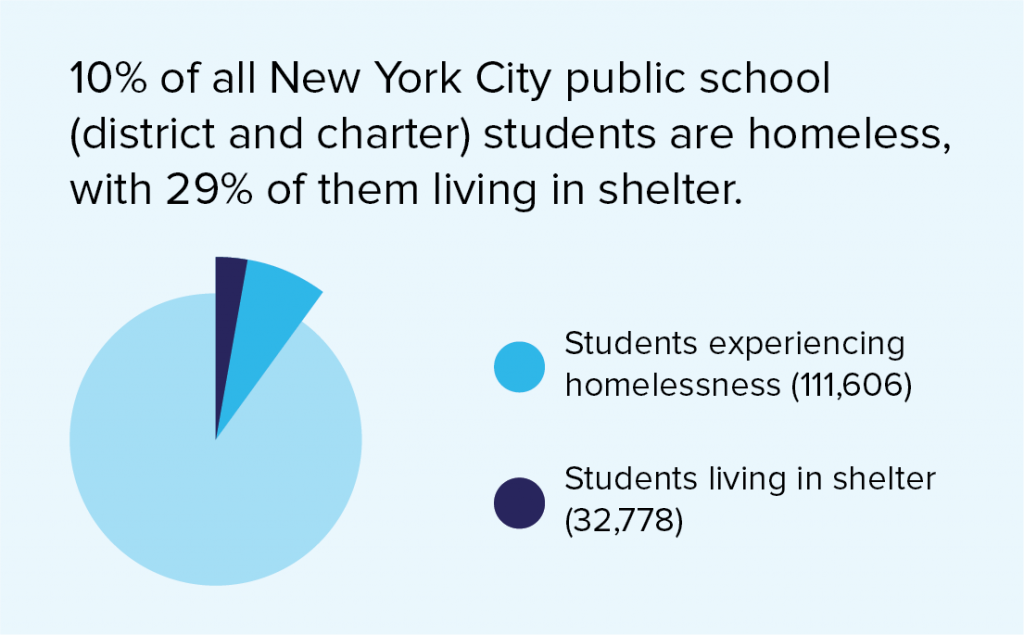
The 32,000-plus students living in New York City shelters each year—over 11,000 students on any given evening4—exceed the entire public-school population of Buffalo, NY, the second-largest city in New York State.5 The right to shelter6 in New York City creates this district within a district, a distinction that the NYC DOE has long recognized by placing dedicated Students in Temporary Housing staff inside shelters to help track attendance, arrange for transportation to school, and liaise between shelter- and school-based staff. Yet even with these supports in place, the pandemic has exacerbated existing gaps on several fronts: Technological Proficiency, Shelter-School Coordination, and Family Engagement.
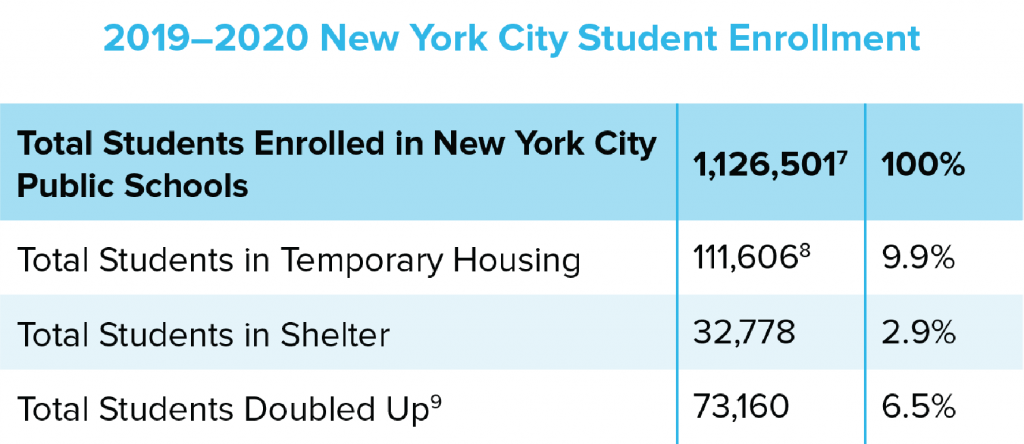
Clustered Schools for Sheltered Students
Before the onset of COVID-19, students living in homeless shelters scored lower than their housed peers on English Language Arts (ELA) and math tests, transferred schools more frequently, and were disproportionately held back.10 Approximately one-third of students in shelter have been identified as having disabilities and have an Individualized Education Program (IEP).11 When the pandemic hit, the public became increasingly aware of the magnitude of family homelessness and how students experiencing homelessness are dependent on schools for many critical social services, such as meals, clean clothes, social–emotional supports (such as counseling), and physical security.12
Of the students living in shelter in School Year 2020-2021, 21 percent (5,433) were clustered in 111 schools in which 11 percent or more of the student body resided in shelter. Two of the schools are part of District 75—with one physically located in the Bronx and one in Brooklyn—and serve students with complex disabilities.13
In School Year 2020–2021, 11 schools had 20 percent or more of their student body living in shelter. These schools are located in 10 of New York City’s 32 Community School Districts and include several neighborhoods with high rates of COVID-19. East New York in District 19 is perhaps the most notable among them: It holds the sad distinction of recording the city’s highest COVID-19 death rate—1,282.42 deaths per 100,000 (zip code 11239).14
A Glimpse at One Shelter Provider’s School Landscape
The citywide sheltered student population may be more clustered than that inside any one shelter. In March 2020, prior to the emergence of COVID-19, there were nearly as many schools represented in each shelter run by Homes for the Homeless (HFH) as there were students. At the Prospect Family Residence in the Longwood section of the Bronx—a residential neighborhood with a heavy concentration of social service agencies—there were 40 students enrolled in 32 schools, with only four students concentrated at the same school. Similarly, at the Williamsbridge Family Residence in a mixed-income, immigrant-dominated section of the East Bronx, there were 59 students attending 47 different schools, with only six clustered at one school. The one exception was HFH’s largest site, the Saratoga Family Residence, located in an industrial area adjacent to JFK Airport in Queens, where up to 255 families reside. At this shelter 166 students were enrolled in 75 different schools, with one school enrolling 51 students.
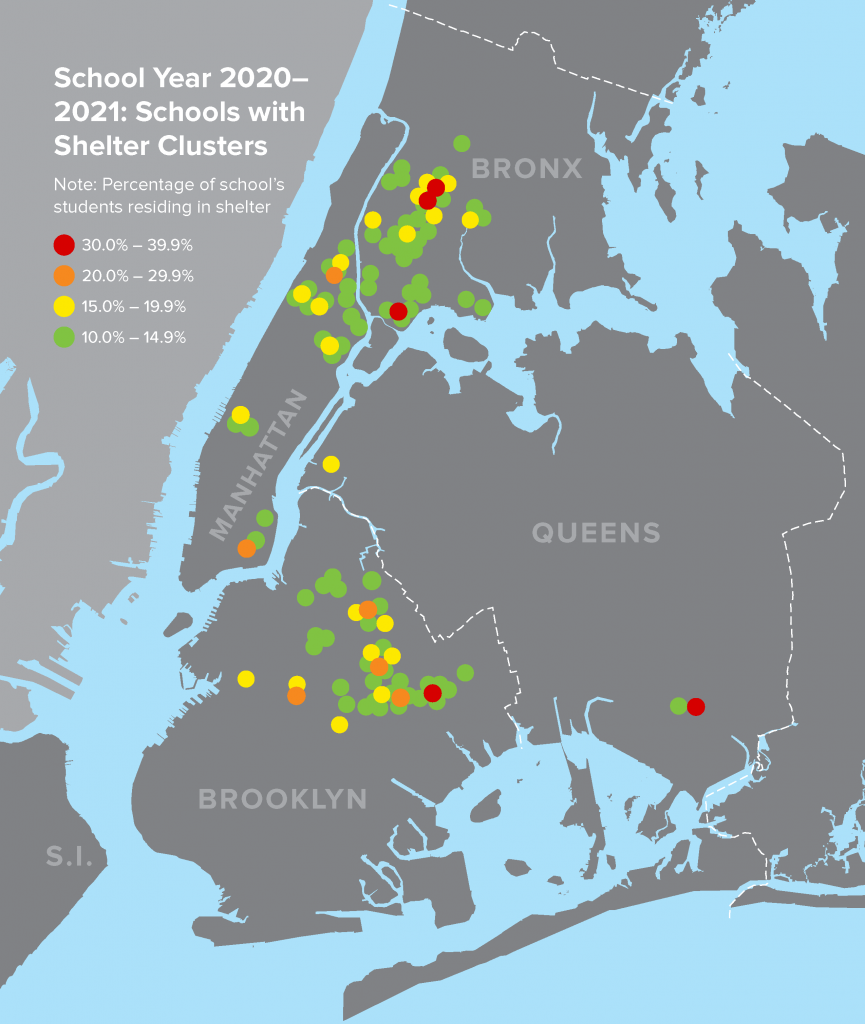
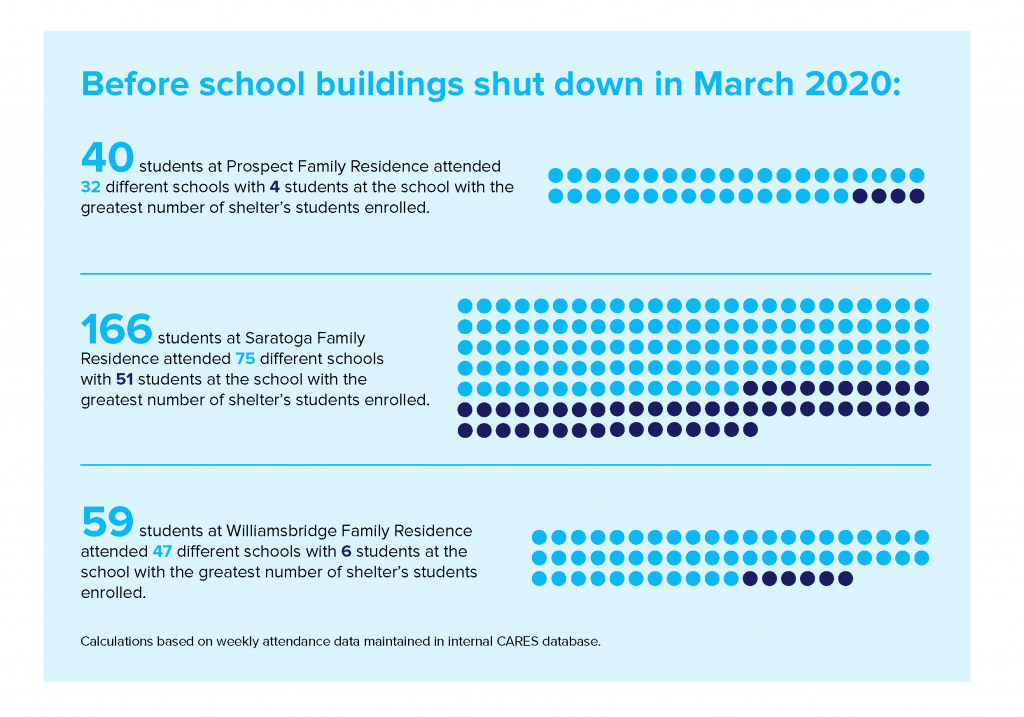
Students living in HFH shelters likely attend such a varied number of schools due to the protections afforded by the federal McKinney-Vento Act. These regulations state that when students become homeless, they can remain enrolled at the schools they were attending when stably housed—their “schools of origin”—even if they move to temporary housing outside the school zone.15 The educational stability this rule provides children during a time of great family upheaval is beneficial, but the abundance of assigned schools found in any one shelter can create challenges for shelter staff attempting to support students academically.
Role of Afterschool
Prior to the pandemic, Homes for the Homeless’ shelter-based afterschool and recreation programs started as soon as school let out for the day. Sessions began with catch-up conversations among staff and parents and homework help for the kids. A thematic activity would follow snack, with student-driven clubs and youth development opportunities a big draw for tweens and teens. At some of the shelters the class also ate dinner together. Scattered throughout the year were workshops involving external partners, with offerings ranging from yoga and dance to cooking and nutrition to college and career readiness. The children always highly anticipated field trips.
Heidy Mendez, Education Programs Coordinator at the Prospect Family Residence, noted that everybody at the shelter stepped up to the challenge presented in Spring 2020 and aided kids in adjusting to the situation. Staff attempted to provide kids with the resources they needed, helped students message their teachers, and served as a supporting system to families.
Michael Chapman, Director of Afterschool and Recreation at the Saratoga Family Residence, says that he and his team did “a lot of knock[ing] on doors, checking up on people, anything that involves us just communicating the best way we can with the parents, as well as the students, just to find a way to help them as much as possible.”
David Belmar, Afterschool Manager at Allie’s Place Family Residence, which opened in Spring 2020 as New York City was in the darkest days of the pandemic, says, “We were a resource for our families, provided homework help, and made ourselves available for families to meet with us because it all seemed quite overwhelming. Our goal was to walk through the process with our families especially with the challenges they were having with DOE. We did our best to be patient, kind and understanding because we were all in this unique situation together. Unknowingly, we became our families’ biggest advocates and served in any capacity they needed. I’m glad we were here for them.”
Staff efforts to assist families were complicated, however, by the many roadblocks they ran into while trying to communicate with the NYC DOE and individual students’ schools.
The afterschool programs at each shelter adapted to a virtual afterschool model after the City determined in April 2020 that remote learning would continue throughout the remainder of the academic year. Mendez says that the pandemic made afterschool even more important to young participants. “We’ve definitely been a support system for them,” she says. “A lot of them were home with mom for the whole day, so this was a little escape for them to interact with other people and do other activities.”
However, like most people after weeks (and then months) of solely virtual engagement, the children eventually grew fatigued with spending so much time in front of a device. The shelters transitioned back to in-person activities with appropriate safety precautions in place as City and State regulations allowed in Fall 2020, but returning has been challenging for many children, a fact that school and out-of-school-time leaders throughout the country have noted with each new layer of reopening.
Fall 2020 Reopening
Given shelter staff’s experiences with slow responses from the NYC DOE in Spring 2020, perhaps it shouldn’t have come as a surprise that the City’s reopening plans for Fall 2020 did not prioritize students in shelter. Despite the flurry of attention paid to their struggles connecting to school in March, there were just two minor references to homeless students in the NYC DOE’s 109-page reopening plan submitted to—and approved by—the New York State Education Department (NYSED). Two policies floated by New York City elected officials that were aimed at supporting students experiencing homelessness were (1) offering the option for in-person schooling five days a week to students residing in temporary housing16 and (2) designating an interagency Director of Students in Temporary Housing within the NYC DOE who is granted the authority to work across agencies to advocate for students experiencing homelessness and housing instability.17
Families with children who experience homelessness in shelter interface with multiple agencies. While the Department of Homeless Services administers most of the city’s family shelter units, school-age children and youth also reside in domestic violence shelters and shelters for people living with HIV/AIDS run by the Human Resources Administration (HRA), unaccompanied youth shelters run by the Department of Youth and Community Development (DYCD), and emergency shelters administered by the Department of Housing Preservation and Development (HPD) for families pushed from their homes due to fire or imminent threat resulting in a building vacate order.18 With this complex system in mind, it makes sense for there to be a designated unit liaising between the schools and each arm of the city’s shelter system, ensuring that students’ educations are not disrupted by their housing instability.
While Mayor Bill de Blasio and then-NYC Schools Chancellor Richard Carranza did not incorporate these particular suggestions into the final reopening plan, some citywide efforts to support students experiencing homelessness have been made since school opened in September 2020. Under threat (and then initiation19) of legal action and continuous media coverage, the NYC DOE redoubled efforts to bring reliable internet access to city shelters or at least ensure that data hotspots to which students could connect their devices were distributed to students in shelter and were in working order. Further, NYC DOE Division of Instructional and Information Technology (DIIT) staff were required to address within 24 hours any work tickets originating from students using city-owned iPads in shelter.20 And while there was no citywide prioritization for in-person learning for students in shelter or other temporary housing, some District 75 (D75) schools for students with complex disabilities had the capacity to offer students five days a week of in-person instruction upon their return on September 21, 2020. Given that nearly 9 percent (2,386) of students enrolled in D75 schools are experiencing homelessness, with 53 percent of those (1,269) living in shelter, it is likely that at least some students residing in shelters benefited from a full year of in-person instruction.21
On November 18, 2020, Mayor de Blasio announced that schools would shut down less than two months after they had opened because the seven-day citywide case positivity average had reached the 3 percent threshold for systemwide closure established by the NYC DOE when schools reopened in Fall 2020. School buildings were shut citywide beginning November 19, and all students were assigned to remote instruction through December 4. On Monday, December 7, schools reopened for grades PreK–5 and welcomed back students who had started the year learning remotely and now decided to opt into hybrid learning. Hybrid or blended learning—the only option for in-person schooling available to the majority of New York City public school students last school year— is a combination of in-person and remote learning in which students spend a portion of the week in the school building (the number of days determined by space and staffing capacity) and the other days learning at home or another community space. District 75 special education schools for grades K–12 returned on December 10, but all other middle and high schoolers citywide were kept remote until February 25, 202122 and March 22, 202123, respectively. The NYC DOE required that all students returning to school buildings consent to in-school COVID-19 testing unless they had 1) a documented medical exemption or 2) a waiver based on the nature of their disability making testing in the school setting unsafe.24
Learning Preferences and Students in Shelter
The learning preference data that the City released in January 2021 did not break down preference for hybrid or remote learning based on student residence. The Community School Districts in which the schools that enroll the largest number of HFH residents from each shelter are located had a fully remote election of 71.6 percent (Bronx District 8), 67.8 percent (Bronx District 11), and 72.1 percent (Queens District 29).25 These figures are all at or above the January 2021 city average of 67.7 percent of students opting for fully remote. A small non-representative sample (n=59) from two shelters in the Bronx26 taken in Fall 2020, which cannot be generalized to the full family shelter population but provides only a snapshot, indicated that resident students selected the hybrid (41 percent) and remote (59 percent) models at a rate not far from the citywide average in October 2020 of 48 percent hybrid and 52 percent remote.27 Families living in the same shelters and attending the same neighborhood schools made different decisions for their children. Even in cases where the school is less than 0.5 miles from the shelter, half of the families opted for fully remote learning while the other half opted for hybrid. Some continued to travel lengthy distances to experience in-person learning, and some who otherwise would have school bus or public transit commutes of an hour or longer opted to stay remote.
The mother of a 10-year-old says that on one hand she liked virtual learning because she and her child could avoid the commute to school. However, she also observed how difficult remote school was on her child. Certain teachers didn’t allow noise in the background of a lesson, a goal sometimes hard to achieve in a shelter. The parent says that the school wanted to make sure that “everything was perfect,” which put additional pressure on her family. She says that her child has an IEP for Attention-Deficit/Hyperactivity Disorder (ADHD) so sitting still and looking at a screen all day is a challenge. Additionally, all of that screentime resulted in her child experiencing headaches and migraines.
The reasons all the families in the sample made the learning model selection that they did are uncertain, but data snippets and personal statements like this illustrate that parents in shelter likely made the same calculations as parents not in shelter. They weighed perceptions of safety, assessment of the need for in-person learning based on their experiences with remote learning in Spring 2020, parental obligations, childcare options, and, perhaps, child preferences around peer socializing. The majority of families with children living in shelter are Black (53 percent) and Hispanic (41 percent), and their intersecting racial, ethnic, and economic identities may have influenced their decisions.28 In a poll conducted by the Education Trust–New York, 50 percent of parents in low-income households and 44 percent of parents of color stated that they were not considering having their children participate in in-person learning in School Year 2020–2021, and parents from low-income households (73 percent) and parents of color (62 percent) were much more likely than white parents (38 percent) and parents from higher-income households (46 percent) to report that their child was enrolled in 100 percent remote learning.29
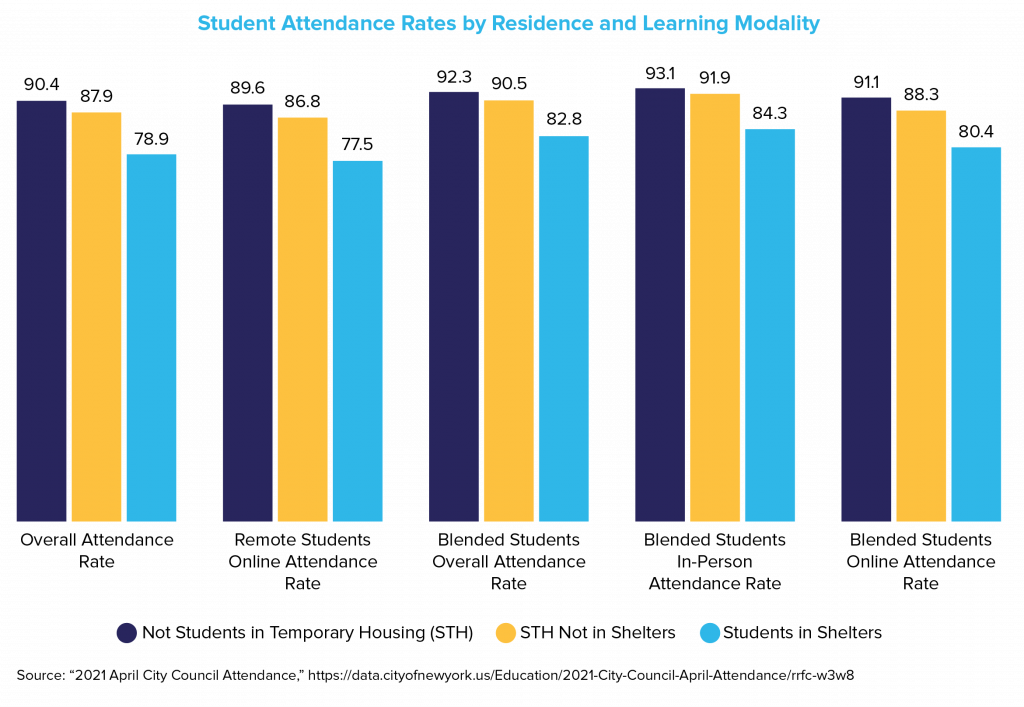
Additionally, there were some indications late last fall that some students in shelter were avoiding in-person learning due to fears around mandatory in-school COVID-19 testing.30
The NYC DOE began releasing disaggregated attendance data in late Spring 2021 in order to comply with Local Law 10 of 2021.31 This law, enacted in January 2021, was sponsored by Public Advocate Jumaane Williams and requires the NYC DOE to post student attendance data every month of remote learning due to the COVID-19 pandemic. The bill called for the data to be disaggregated at the school, district, and grade level and report on other demographic factors, including whether a student is living in temporary housing other than shelter (“doubled up”) or living in shelter.32 Student attendance rates for April (the most recent month available on NYC Open Data), show a clear difference in overall attendance rates and rates for each learning modality for students in shelter compared to students living in permanent housing and non-shelter temporary housing. Students learning remotely in shelters had the lowest attendance rates of all groups. Yet while this data compilation was eventually made publicly available, the NYC DOE attendance tracker shared with shelter case managers and education staff was not updated in real time to reflect whether students were attending school in-person, remotely, or in a hybrid/blended manner, leaving the gathering of this information—which the schools and NYC DOE had at their fingertips—to shelter staff.
It Takes a Network
Throughout the 2020–2021 school year, the wide range of schools that children living in each HFH shelter attended persisted. This trend continued even as the overall number of students in HFH shelter dipped slightly alongside the overall decreasing number of families with children in shelter citywide. By May 2021, Allie’s Place had 53 students enrolled in 39 schools and only 7 clustered in the same school. Prospect and Williamsbridge each had 5 students at the most frequented school. Saratoga had 131 students enrolled in 83 schools but now only 26 students—down from 51 in March 2020—attending the most frequented school.
Given the large number of schools children at each shelter attended, it is unsurprising that communication with the NYC DOE was difficult. Many voicemails were left, and it was unclear who to call at particular schools. Michael Chapman at Saratoga recounted the day when a call finally came in from the NYC DOE. He expressed to the voice on the other line how relieved he was, because he had been trying to reach someone for such a long time. However, Chapman’s enthusiasm dropped when it turned out that the call was related to a singular concern about a child—one who had ultimately moved out of the shelter some time ago—who had not logged into class. Chapman tried to shift the conversation to the broader technological and instructional needs of the hundred-plus students living at Saratoga, but when he tried to ask about additional support, the caller replied, “Oh, well, I don’t handle that; you’d have to call so and so.” Chapman lamented the quick divide following an initial connection.
Communication challenges likely also arose from DOE staff working outside their usual locations. Citywide, many shelter-based family assistants and in-school attendance teachers charged with monitoring individual students’ absences33 received medical accommodations to work remotely. Additionally, some shelters had limited space and needed to prioritize shelter operations staff for in-person work, forcing their DOE family assistants to work offsite.34 Face-to-face interactions may be a family assistant’s most powerful tool in connecting with a family. Limited opportunities for in-person dialogue may make it difficult for the family assistant to fully convey learning options and best support each child’s access to education.
The NYC DOE’s Students in Temporary Housing staff were stretched thin prior to the pandemic. The number of NYC DOE shelter-based family assistants has not increased in the last decade, despite a large growth in the number of school-age children living in shelter. There are currently only 117 family assistants, resulting in a ratio of one family assistant for every 76 students in shelter, according to the latest available (June 2021) DHS population-by-age census.35 And those 76 students could very well attend at least 50 different schools. This is why Advocates for Children implored the Mayor and Chancellor to add 150 shelter-based Students in Temporary Housing Community Coordinators to the SY2021–22 budget.36 The request didn’t make the final cut.
Raising Technological Proficiency for Staff, Parents, and Students
While parents throughout the city with varying degrees of technological acumen struggled with navigating remote learning, doing so was a particularly difficult hurdle for families living in shelter. Chapman at the Saratoga Family Residence says that the schools could have done a better job orienting parents to the various technologies. Parents wanted to help their children, but they were overwhelmed and needed support. Many parents experiencing homelessness are coping with the barriers that contributed to their living in shelter and are either new English speakers or did not graduate high school themselves and may not feel confident in their ability to directly support their children’s schoolwork.37 They need meaningful, targeted, and culturally competent assistance that builds on the existing network of shelter staff, shelter-based DOE staff, and school staff.
The City’s current operational efforts concerning access to technology are important and will prevent students from exclusion when school must operate remotely, whether due to safety concerns or inclement weather, in the future. Students learning in the 21st century need consistent access to internet-enabled devices in order to achieve academic proficiency and prepare for careers and civic engagement in a world that will require technological fluency.38
Shelter-School Coordination
Dedicated on-site staff worked exceptionally hard to help children and families through the crisis, navigating changing rules and regulations from the City and State. However valiant their efforts, it is impossible for a small staff to master all learning formats, tools, and grade-level requirements while concurrently navigating the idiosyncrasies of each school.
Chapman believes that a better bridge must be built between the NYC DOE and individual shelters. The NYC DOE can do much more to reach out to shelters with comprehensive guidance and solutions. Each HFH shelter has existing relationships with several of the schools that resident children attend, but it’s difficult to forge deep connections when new schools and students are constantly coming into or moving out of the picture.
Belmar at Allie’s Place thought that not enough attention was given to the struggles of parents during this difficult time. “I understand the concerns for kids not doing the work and participating virtually in school. However, I’m not sure if the DOE paid attention to how the pandemic impacted parents and whether they had the tools needed to ensure that their child/children were able to do the work. In my opinion the mental health of families should have been given more of a priority.”
Family Engagement
HFH’s Education Programs staff prioritizes relationship building. When Heidy Mendez at Prospect initially meets a family, the first thing she tells parents is that they should be comfortable coming to her for support, whether they need help navigating issues at school or translating forms, or just want a friendly person to actively listen as they share their daily wins and worries. “I show them that I care about their children and family, that they’re safe, that they are loved, and that they’re treated well,” she says. “This way we build trust and form these relationships.”
Chapman notes that as much as shelter staff try to make personal, authentic connections, many families enter shelter with some level of trauma and “come here in a guarded situation, where they do not trust the quote unquote, institutional environment.” He asserts that this mistrust—particularly the fear of potential Administration for Children’s Services (ACS) involvement—sometimes precludes families from taking advantage of positive programmatic offerings.
Starting from Today, Looking Forward
As the grim one-year mark of the first school closures passed, glimmers of hope emerged. There was excitement in Spring 2021 over five days of in-person learning being made available to elementary school classrooms with adequate space for distancing,39 another opt-in window for students to shift from remote to in-person learning, and the increasing availability and effectiveness of vaccines for youth ages 12–17.
Like New York City families living in permanent housing, families living in shelter have similar concerns and hopes for the 2021–2022 school year now underway. The mother of a seven-year-old expressed few concerns for the start of the academic year because her child’s school has taken great precautions “in making sure everything is nice and clean. The children are safe. And so far, so good. I have no complaints … They’re able to keep six feet apart.”
The mother of a nine-year-old has noticed an increase in conflict as children interact with each other less frequently. She is concerned that kids have forgotten how to talk to each other and how to treat each other. “The more interaction [they have], the less conflict,” she explains.
Belmar says parents are wondering how the situation is going to affect children this year and if children will be able to catch up. What support are schools going to provide children who have fallen behind academically, he asks, so they can work toward grade-level standards? The mother of a ten-year-old concurred. In Summer 2021 she related that her child would be entering middle school in September and would need to adjust to a new way of learning. She had become accustomed to remote learning in fifth grade, but because of COVID-19, “her mindset is back at fourth grade again. So, I don’t know if she’s gonna understand this big topic of sixth grade [after being] stuck in front of the screen for the last year. Might be difficult.”
Students in shelter are already dealing with enough twists and turns, and the educational and social-emotional stakes for them are high with two—going on three—academic years now disrupted by this pandemic.
Much has been made of the loss in NYC schools’ enrollment. Data will eventually reveal if that reduction is permanent. It is striking that the loss in the overall student census is nearly equal to the number of students who lived in shelter during the last year for which data is available. As a sum on a spreadsheet, students living in shelter are a small portion of the overall student body. However, every single one of those students should be a signal to the DOE’s leaders that they cannot make good on their vision and mission, “to provid[e] every single child, in every classroom, in every New York City public school, with a rigorous, inspiring, and nurturing learning experience,” unless they proactively work to elevate the needs of students in shelter.40 Data on students in shelter must be deliberately collected and disaggregated throughout this school year and during every academic catch-up program41 so tailored solutions can be crafted with input from all stakeholders, including, importantly, shelter staff in direct relationship with students and their parents. To ensure an equitable education for students in shelter as New York City rebounds, everyone who works with children experiencing homelessness must collaborate to build sturdier bridges of support. Homeless children should be able to learn free from interruptions, in environments primed to help them succeed, with access to all learning tools, academic assistance, and robust social-emotional supports.
Robyn Schwartz has been working for Homes for the Homeless for more than 15 years, currently serving on the policy team, among other projects. Linda Bazerjian serves as Managing Director of Communications for Homes for the Homeless.
How to Connect:
Robyn Schwartz / RSchwartz@HFHnyc.org
Linda Bazerjian / LBazerjian@HFHnyc.org
Resources:
Watch this video for a deeper look into this topic.
Highlights from Beyond Housing 2020
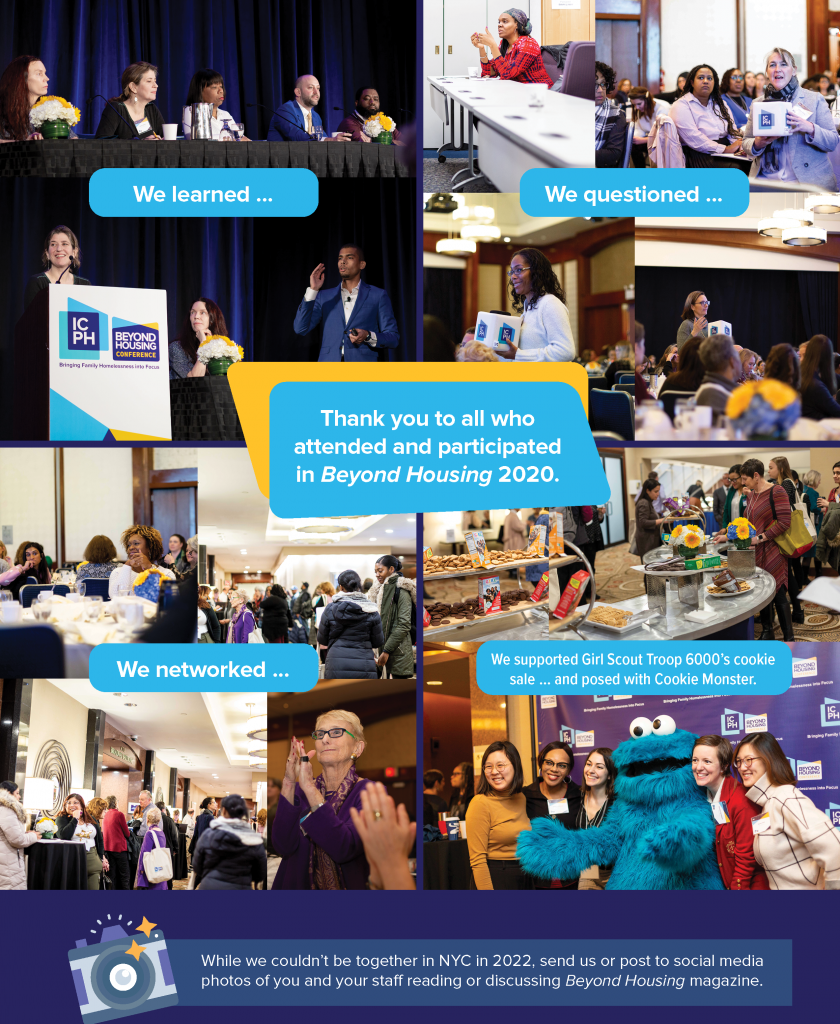
Family Homelessness Providers and Head Start—Natural Partners: Taking the Model Statewide
By Tracy Duarte, Grace Whitney, Joe Willard, Omari Baye, and Roslyn Edwards
Note: Citations and sources for data are included in the PDF version of this document available by clicking Downloads underneath the Table of Contents.
A young mother and her children moved into a Philadelphia-based homeless emergency housing facility. She experienced trouble balancing caring for her three-year-old son and her seven-month-old daughter while looking for work and housing. She wanted to keep her baby close for multiple reasons, but also knew that her infant would benefit from developmentally appropriate services. Unfortunately, this household was one of dozens of families with young children in this particular shelter, and the homeless agency lacked staff knowledgeable in child development and the city’s landscape of high-quality childcare options. This mother’s case manager was overwhelmed and unaware of any community-based childcare programs. One day, an Early Childhood Education (ECE) Specialist from the People’s Emergency Center (PEC) contacted the case manager and informed her that she could help any parent access early learning programs anywhere in the city. After speaking with the young mother, the ECE Specialist introduced the family to the Family Community Involvement Specialist at an Early Head Start. Within days following the intake process, the family began receiving Early Head Start services. With childcare support, the parent was able to spend more time seeking employment and finding housing and, ultimately, bring newfound stability to her family.
Children experiencing homelessness—like those described in the introductory scenario—are more likely to lack access to early childhood programs of any caliber, let alone those of high quality such as Early Head Start. This presents a missed opportunity because these programs can provide a positive buffer to the adverse effects of homelessness and the range of co-occurring trauma or toxic stress that often accompany unsafe, unstable, and inadequate housing.1 It is particularly urgent to address Adverse Childhood Experiences (ACEs) and the accompanying toxic stress experienced at a very young age as they can follow children into adulthood, causing serious problems.2 The experience of homelessness—one such ACE—can disrupt a young child’s development, resulting in persistent delays and increased risk for poor health and academic outcomes. Infants and children experiencing such developmental delays can benefit not only from high-quality childcare but from early intervention services—supports such as speech, physical, or occupational therapy.3
In the mid-2010s, the People’s Emergency Center (PEC), a West Philadelphia-based nonprofit that provides affordable housing units, job training, parenting and early childhood education, financial education and planning, life skills, and technology classes to families, children, and youth experiencing homelessness, turned its attention to the pressing need for high-quality childcare and early intervention services for children experiencing homelessness, culminating in the creation of “Building Early Links for Learning,” or BELL. The BELL model is a multipronged approach that combines elements of advocacy, research, program design/implementation, and network-building to transform access to high-quality early education for homeless families with young children. This article discusses the path that led PEC to BELL and outlines how other localities can build their own community’s capacity to respond to the needs of children and parents.
One City’s Story of What Works: Ringing the BELL for Early Education in Philadelphia
Prior to 2010, Philadelphia’s homeless housing system had little focus on young children, reflecting the status quo in most regions throughout the United States. However, for many years PEC had been a leader among emergency and transitional housing providers in creating environments based on child and family needs. The organization’s advocacy eventually led to multi-million-dollar private-sector investments to improve how young children are supported in Philadelphia and a statewide effort to align practices and improve coordination among state and private agencies, with a special emphasis on building partnerships between family homelessness providers and Head Start. Throughout this article and on the Beyond Housing magazine section of ICPH’s website, links are included to provide readers with resources and inspiration to spark similar projects in other localities and states.
Precursors to BELL
Roughly a decade ago, PEC led the Family Service Provider Network (FSPN). This coalition pushed the City to create the Children’s Work Group (CWG)—solely focused on homeless children—in response to a then-mandate from the City’s Deputy Manager for Human Services requiring City departments to cooperate with community partners to establish short-term goals toward ground-level change. Through its work groups, which involved more than 40 private- and public-sector leaders, CWG championed the needs of young children by better integrating the homeless housing and early education and intervention systems.
Within four years, the following outcomes were achieved:
- Homeless housing providers were contractually mandated to use the evidence-based Ages and Stages Questionnaire widely implemented in medical and educational settings nationwide to identify developmental delays so children experiencing homelessness could better access the City’s early intervention system.4
- The first-ever citywide report5 on the status of homeless children was commissioned and detailed families’ experiences with such issues as lead poisoning, school truancy, immunizations, and health insurance enrollment. For the first time ever, Philadelphia had a data-informed view of the challenges faced by young children residing in emergency housing.
- A citywide trauma-focused curriculum6 was developed and implemented that trained more than 350 homeless housing personnel. With expanded coordination capacity, this effort created the environment to support local development of a parenting curriculum called the Family Care Curriculum that remains available to the family homeless housing system.
- Strategies were coordinated to assist the public school district in identifying and supporting students experiencing homelessness.
Building BELL
The Children’s Work Group Early Childhood Conference, co-led by PEC since 2016, emerged as the main body to sustain efforts to increase access to early childhood education for young children experiencing homelessness. PEC’s deep commitment to this issue led it to become an early adopter of the Early Childhood Self-Assessment Tool for Family Shelters, published in 2015 by the Administration on Children and Families (ACF). PEC also sought ways to extend the tool, working with a graduate student to create a companion 14-item parent survey.7 The parent survey, while focused on determining parents’ own service needs, revealed that parents often feel unheard, resulting in suggestions that parents participate in policymaking.8 It also surfaced that the children of parents who had more positive perceptions of support from family service providers for their unique needs in the shelter environment had better social-emotional competence than children of parents who did not.9
Partnering with the late Dr. Staci Perlman (who worked closely with the ACF team responsible for the early childhood self-assessment tool’s development),10 Dr. Janette Herbers, and Dr. J. J. Cutuli, PEC received a two-year planning grant from the William Penn Foundation to better understand utilization of early learning by parents experiencing homelessness and the challenges they face. This effort became known as “Building Early Links for Learning” or BELL. During this planning phase, consensus emerged around the importance of designating key contacts who could intentionally sustain working relationships with individual childcare programs and maintain regular communication between the homeless housing and early education sectors, as well as between programs and families.
| Head Start is a Great Society program that was a key component of President Lyndon Johnson’s War on Poverty. It provides preschoolers from low-income households with community-based, culturally competent full-day high-quality childcare programs aimed at “meet[ing] their emotional, social, health, nutritional, and educational needs” and home visiting and/or daycare programming to 0–3-year-olds through Early Head Start.11 |
In 2017 BELL released a report that offered a blueprint for increasing the enrollment of children experiencing homelessness into Head Start and other high-quality early learning programs. The same year the aforementioned report was released, PEC received an implementation grant from Vanguard Strong Start for Kids that allowed the organization to put the findings into action. PEC hired designated key contacts—Early Childhood Education Specialists/Early Childhood Navigators12—who could assist parents throughout the homeless housing system in navigating the early childhood system and accessing those programs that best met their child’s and their family’s needs. The creation of this hub strengthened collaboration with Head Start and expanded efforts to connect families in the City’s homeless housing system with subsidized childcare.
Continuous Improvement
In 2019 Dr. J. J. Cutuli evaluated the BELL Project’s impact. Among the key findings was that it is insufficient to track enrollment in early childhood programs. Agencies and policymakers must also track program quality since many children—notably infants and toddlers—living in emergency homeless housing were enrolled in programs that did not meet the quality standards outlined by the State of Pennsylvania’s early education Quality Rating and Improvement System (QRIS), Keystone STARS. Evidence gathered from these efforts is beneficial, as childcare policy is adapted to meet federal requirements to prioritize children and families experiencing homelessness for childcare subsidies. These changes will help connect homeless families with quality programs.
| All young children, no matter where they live, eat, or sleep, greatly benefit from high-quality early learning programs. Quality is an essential but often overlooked consideration for children experiencing homelessness. States define standards for high-quality programs by using the national quality framework promoted by ACF—the QRIS—and evaluating early learning sites against those standards, building a culture of continuous program improvement.13 The most common indicators for quality center around eight categories: staff qualifications, learning environment, program management, health and safety, curriculum, family partnerships, child assessment, and positive interactions.14 Critical components for high-quality programs center on how children are nurtured inside the classroom and how enrolled families are continuously supported. |
Research findings continue to indicate that housing and early childhood providers should designate staff contacts who can facilitate family access to needed services, and having an intermediary, like BELL, to establish and maintain this structure is helpful.
BELL has also influenced the broader PEC organization, drawing attention to the value of tracking the enrollment in early childhood programs of the young children in families residing in PEC’s shelter and transitional housing programs. PEC is currently building links with home visiting services as well.
Statewide Expansion
What started as city-level advocacy morphed into statewide advocacy as PEC leadership realized that a full rollout that anchored Head Start as the best possible intervention for homeless children would require state support. In 2018, PEC partnered with the Pennsylvania Head Start State Collaboration Office (PAHSSCO) to draft recommendations to address state-level regulations and funding gaps and to create the PA Homelessness Stakeholders Group. PAHSSCO brought together state entities, including the PA Education for Children and Youth Experiencing Homelessness (ECYEH) Program, PA Office of Child Development and Early Learning, PA Bureau of Managed Care Operations, and Center for Schools and Communities; nonprofit leaders like the PA Head Start Association and PA Partnerships for Children; and others to jointly prioritize the educational needs of young children experiencing homelessness.
Recently, PAHSSCO, PEC, and Dr. Grace Whitney began analyzing Head Start data related to children and families experiencing homelessness or with housing-related needs, such as assistance with utility bills. Data is being analyzed and broken out according to the Commonwealth’s 16 Continuums of Care (CoC) to help CoCs better understand the experiences of and resources available from Head Start providers. Data will be shared with communities with the goal of helping CoCs find families they may not have already connected with needing housing supports, increasing enrollment in Head Start, and strengthening working relationships between housing providers and Head Start. Notably, this analysis project is also helping Head Start better understand the housing needs of Head Start families and the high demand for housing-related services among enrolled families. One in three PA Head Start families requesting some type of family services from their programs has needs related to housing, and the following graphs of Head Start data15 grouped by CoC illustrate that fewer than one in three PA Head Start families experiencing homelessness find housing during the program year.
| The Continuum of Care (CoC) program promotes communitywide commitment to the goal of ending homelessness. The program provides funding for efforts by nonprofit providers and state and local governments to rehouse homeless individuals and families while minimizing the trauma and dislocation caused to homeless individuals, families, and communities by homelessness.
Continuum of Care Program | HUD.gov / U.S. Department of Housing and Urban Development (HUD) |
Moving Forward for Families
BELL’s activities continue to flourish in Philadelphia and across the state. In response to COVID-19 and the closures that followed, BELL adapted its outreach, training, and enrollment efforts to a virtual format. Although meeting and training methods were less than ideal, BELL was able to keep its finger on the pulse of emergency housing providers and the experiences of families residing in shelter throughout the crisis. BELL, in partnership with the PAHSSCO and PA ECYEH, assisted emergency housing program leadership with accessing grant funding to purchase computers, signal extenders, hotspots, and learning software to ensure that school-aged children ages three to 18 had adequate WiFi access for remote learning. In addition, with support from Vanguard, the William Penn Foundation, and the Reinvestment Fund, BELL delivered Lakeshore socio-emotional activity kits to families in shelter with children ages birth to five to support parents with engaging and maintaining healthy attachments with their children through play, understanding that seclusion and isolation challenged the emotional regulation of those forced to parent round the clock in limited spaces. The Early Childhood Education Specialists also created a “Sit Calm” story time series to engage children and provide parents with a moment of respite.
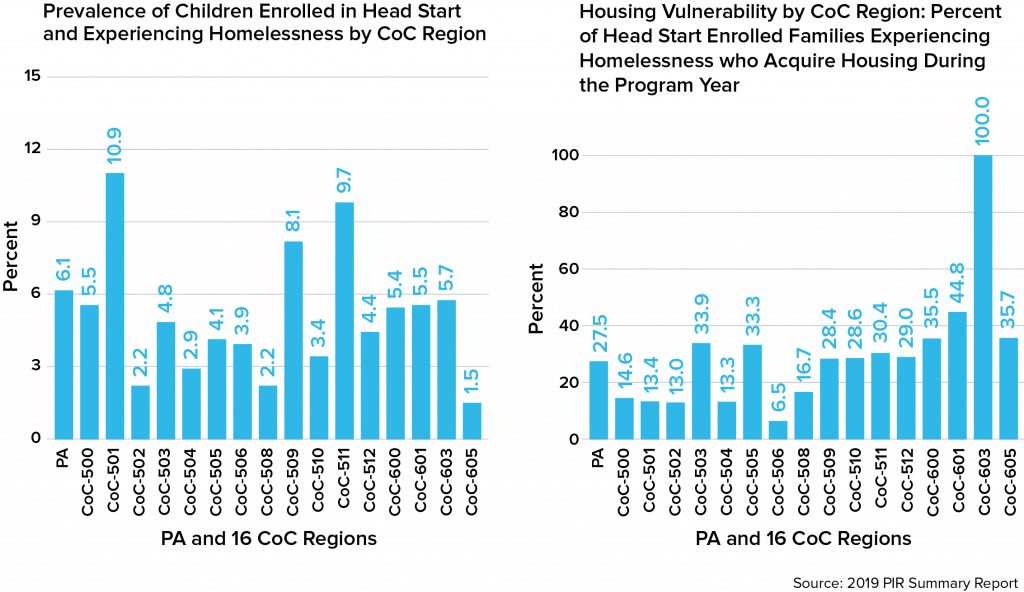
The most recent BELL Summit for policy leaders took place on September 29, 2021. The state-level PA Homelessness Stakeholders group is growing in influence, and PEC continues to lead the monthly Philadelphia-based CWGEC, enhancing collaboration between housing and early childhood providers as they learn together and from one another through presentations and joint training. The need for trauma-informed training is notable and has generated new partnerships with the mental health provider community, including the PA Association for Infant Mental Health. Current challenges created by the COVID-19 pandemic have added urgency to the mission of working more effectively together to address deep needs and to maximize use of new—and perhaps time-limited—resources.
The BELL model did not emerge overnight, and any community that sets out on this work should be aware that it will take time and fortitude to build a strong network. However, PEC stands ready to discuss the process with any community or CoC looking to replicate its efforts. The key is to locate natural partners, build relationships, and together champion high-quality early education for young children residing in shelter and other homeless housing.
Tracy Duarte is the Director of the Pennsylvania Head Start State Collaboration Office. Grace Whitney is a consultant who previously worked as the National Director for Early Childhood Initiatives for SchoolHouse Connection and for many years served as Director of Connecticut’s Head Start State Collaboration Office. Joe Willard has been the Vice President for Policy at the People’s Emergency Center (PEC) since 2007. Omari Baye is the Manager of PEC’s Building Early Links for Learning project, and formerly managed one of Philadelphia’s largest family emergency housing programs. Roslyn Edwards has been PEC’s Director for Early Childhood Education programs since 2018.
How to Connect:
Tracey Duarte / Tradua@pakeys.org
Grace Whitney / grace.whitney.124@gmail.com
Joe Willard / Jwillard@pec-cares.org
Omari Baye / OBaye@pec-cares.org
Roslyn Edwards / Redwards@pec-cares.org
Resources:
Watch this video for a deeper look into the topic:
To learn more about BELL, download reprints of the BELL NEWSLETTER here:
Q & A With … Homeless Education Coordinators in Los Angeles County
Note: Citations and sources for data are included in the PDF version of this document available by clicking Downloads underneath the Table of Contents.
The Beyond Housing conference has always been a place where professionals with wide-ranging experience levels—and from communities as different as Little Rock, Arkansas and Seattle, Washington—can come together with a common purpose: determining how to best serve the families impacted by housing instability. The “Q & A with” section came about after hearing from people—some at the beginning of their careers, others seasoned professionals but new to working on behalf of homeless families—who want to better understand some of the field’s commonly used terms, laws, acronyms, and studies. This first installment focuses on student homelessness and such terms as “McKinney-Vento Act,” “homeless liaison,” and “school of origin.”
Homeless education coordinators and liaisons across the country are dedicated to bridging divides and facilitating coordination among schools, families, and the shelter and housing system. Experts Leeane Knighton and Dr. Jennifer Kottke have many years of combined experience navigating the world of homeless education and homeless services. Knighton is a coordinator for homeless education with the Los Angeles County Office of Education (LACOE). She is positioned in and partners with the lead agencies in Los Angeles County’s Coordinated Entry System. Kottke supervises the coordinators and the entire homeless education program for LACOE, bearing responsibility for supporting families with children and youth experiencing homelessness in 80 school districts (Los Angeles Unified—the second-largest school district in the United States—plus 79 smaller entities) and over 380 charter schools across the county.
Editor’s note: Under the McKinney-Vento Act, children and youth are considered homeless if they are “sharing the housing of other persons due to loss of housing, economic hardship, or a similar reason; are living in motels, hotels, trailer parks, or camping grounds due to the lack of alternative adequate accommodations; are living in emergency or transitional shelters.” Children also meet the definition of experiencing homelessness if they are residing in a “public or private place not designed for or ordinarily used as a regular sleeping accommodation for human beings” or if they are “living in cars, parks, public spaces, abandoned buildings, substandard housing, bus or train stations, or similar settings.” Finally, the children of migratory agricultural workers (“migratory children”) receive protections under McKinney-Vento if their living situation meets the aforementioned criteria.2
What is the McKinney-Vento Homeless Assistance Act?
Leeane: This is a federal law that stipulates that all children have a protected right to attend any publicly funded school and fully access all school-sponsored programs while they or their families experience forms of homelessness.
Jennifer: The McKinney-Vento Homeless Assistance Act really changed the landscape on how schools serve and support students experiencing homelessness. The act provides a definition of what homelessness looks like for children ages 0–22, and it outlines rights and protections for this population. The McKinney-Vento Assistance Act has been a federal law since 1987.
California has passed laws to strengthen McKinney-Vento in practice. For example, SB 400 of 20211 requires that school staff who work with youth experiencing homelessness receive training annually, which must then be verified by the California Department of Education. I know other states have passed their own state laws to strengthen McKinney-Vento and these laws look different than our laws. We always say that McKinney-Vento trumps local and state [laws], so state and local laws cannot supersede McKinney-Vento, but they can strengthen it.
What more can schools and communities do to educate families and youth about their McKinney-Vento rights? And what kind of outreach can be conducted with allied professionals in other community-based organizations/settings (healthcare providers, food security-focused organizations like food pantries, childcare centers, afterschool programs, houses of worship, barber/beauty shops, etc.) so they have a better understanding of McKinney- Vento rights?
Leeane: We advise that schools have McKinney-Vento posters placed in their front offices and have the liaison’s name listed prominently on their websites. Schools also have a Student Housing Questionnaire as part of their enrollment packets. So, families will fill out this form that specifically asks them to describe their housing situation, including whether they are doubled or tripled up.
When we get the opportunity to table community events, we offer informational brochures and will answer questions. We also work with Head Start and Early Head Start providers to bring awareness to the staff. We present to faith-based organizations regularly. During COVID-19, we virtually meet with stakeholders weekly for case conferencing and to share updates on opportunities, such as job training programs for their participants and scholarships.
Jennifer: We have seen many of our LEAs (Local Educational Agencies) do creative things about outreach and engagement. LAUSD and several other of our LEAs do public service announcements. They work with local public television systems or public radio to put out mini-ads about eligibility for McKinney-Vento. Many of our LEAs place posters about McKinney-Vento around the community in public places like laundromats, grocery stores, pharmacies, libraries, coffee houses, etc. We have many LEAs that have great relationships with local partners, and they collaborate over services and identification. A school might have a great partnership with a local foodbank and the foodbank will let them throw a flyer into their food boxes each week to make families aware of McKinney-Vento. Our LEAs have become very creative and have had to be even more creative during COVID-19.
When I sat in a district as a McKinney-Vento Liaison I worked very closely with my local entities. I attended community groups, I worked closely with my housing partners, I worked closely with my food partners, and I partnered with my local faith-based entities. I was always open and willing to training any of our partners. I was a McKinney-Vento Grantee, so I had a lot more ability to expand myself and my staff into the community. My district also supported my work because of our high count of students experiencing homelessness. A lot of these connections were made because I understood that I needed to get off my campus to leverage the few dollars I had to build a program for my students. Many of our LEAs are connected with their communities and participate with their local allied professionals, however, many more of our Liaisons struggle with building community networks. Much of this has to do with the fact that many of our Liaisons wear many different hats along with being the Homeless Liaison, so they struggle to get into the community to make these connections or they just do not have the availability to offer trainings. Additionally, we often struggle with a high turnover rate for McKinney-Vento Liaisons. It would be optimal that we would be doing this work, but this really depends on the capacity of the LEA and the capacity of the Homeless Liaison in the LEA.
What are the differences between the kind of services communities with McKinney-Vento grants vs. those without grants can offer?
Jennifer: McKinney-Vento grants are limited funding that is offered out to LEAs (school districts and charters) in the form of grants. Communities do not get McKinney-Vento grants; LEAs are the entities that can apply for these funds. This grant funding is considered “sprinkles on the cupcakes”—extra funding that is used on top of your funding that must already be set aside by your LEA for students experiencing homelessness, regardless of your student count. If a district or charter has no students experiencing homelessness, they are still required to have money available. If they did not set aside any money and a student experiencing homelessness comes to their district or charter and has educational barriers that need to be removed—such as lack of transportation—the LEA will have to pull funding from their general fund.
For an LEA that is not a McKinney-Vento Grant Recipient, services will be rendered to meet the letter of the law. You will see things like transportation being provided, possibly uniformed clothing (if required), referrals to local resources, and basic school supplies. McKinney-Vento Grant Recipients may hire additional staff with funds, may use money to hold events, pay for staff to offer out classes, have transportation agreements with local taxi companies to provide transportation, pay for tutoring services … and the list goes on …
Leeane: Regardless of whether a school community has money earmarked for McKinney-Vento families, they must ensure that students continue to fully access all school-related programs, like sports, field trips, etc., regardless of personal housing struggles. If a McKinney-Vento student cannot afford to pay for the football or cheerleading uniform, the liaison will ensure that the student does not quit over lack of funding. The same is true for participation in clubs and afterschool activities. We know that the more a student engages with their school, the more willing they are to continue to attend school. This is important because students experiencing homelessness are 87 percent more likely to drop out of school than their housed peers—often due to chronic absenteeism. Lack of a high school diploma, according to a study conducted by Chapin Hall, is the greatest predictor of homelessness for [youth] ages 18-24.3
How can family shelter staff, including housing specialists or navigators, use McKinney-Vento to support children experiencing homelessness and housing instability?
Jennifer: These professionals can support students by advocating and providing support around school of origin [the school a child attended while permanently housed or the last school they attended]. Under McKinney-Vento, students have the right to remain in their school of origin to reduce disruption in the learning process. Housing specialists, family shelter staff, and homeless liaisons should also collaborate around services for families. If a student in a shelter needs school supplies, shelter and school staff should have some type of internal process to create a referral for the student to be served and supported.
Leeane: Shelter staff can support families by familiarizing themselves with their residents’ McKinney-Vento rights and protections. For example, if a student attended School B until the spring, but moved to a shelter where School A is located, both schools might agree to split the costs of bus fare if the student takes public transportation through the end of the school year. If school liaisons do not provide transportation or negotiate with each other on transportation accommodations, then the student may end up not attending (or may even drop out) and the school will be out of compliance with the law.
How can schools work with shelters and housing staff to coordinate support for students experiencing homelessness and housing instability?
Jennifer: We encourage homeless liaisons and shelter and housing staff to coordinate support for families experiencing homelessness and housing instability. This looks different across the county, because in some locations, there are very few shelters, while in other areas there are numerous shelters. Creating collaborations is critical to ensuring that school of origin is honored, that students can have a quiet place to study, that parents are encouraged to be part of their student’s education process, and that there is a culture of education within the shelter. Shelter staff should immediately reach out to local homeless liaisons when a student enters their program or connect with a local school if it appears that a student may not be attending school. Effective coordination should include a wrap-around team for the specific purpose of protecting education.
Leeane: Shelter staff may offer time for a representative from the school to speak with residents. Even if the families do not have children attending that particular school or district, the information presented still applies, even for families with children who are not school-aged.
What role do school or district homeless liaisons play in supporting families and students experiencing homelessness and housing instability?
Jennifer: Homeless liaisons play a pivotal role in supporting students experiencing homelessness. The homeless liaison’s role, by federal definition, is to remove barriers to education. Homeless liaisons work with families and students experiencing homelessness to ensure they have the necessary tools to be successful in their academic journey. They also connect families and youth with outside community resources. The liaison can assist in making housing referrals to connect families with stable housing.
Leeane: Because they respond to the physical, psychological, and emotional urgencies characterized by the trauma of homelessness and housing instability, liaisons wear many hats. They provide mental health referrals, organize food pantries or clothing closets, and maintain an inventory of school supplies to distribute at any point in the school year. (Students who qualify for McKinney-Vento services typically do not enroll at the beginning of the school year due to frequent moves.) Most vital, though, is they simply listen to the families and youth who seek their advice and input. They also support their school community by keeping staff informed of broad policies, such as immediate and continuous enrollment for students identified as qualified for McKinney-Vento services.
What common signs should classroom teachers be on the lookout for if they suspect a student is experiencing homelessness?
Jennifer: One common sign that classroom teachers can be on the lookout for is absenteeism. A student may also appear to be wearing the same clothing over and over or struggling with hygiene. The student may seem unprepared or lack supplies to complete their homework. Students might mention that they are hungry, having problems sleeping, or acting withdrawn and struggling to make friendships. Additionally, teachers may see a long history of schools in their student records, which may indicate repeated movement due to unstable housing. Parents may be absent or hard to reach due to working long hours at multiple low-wage jobs. A student may also be reluctant to share or may even be very clingy due to instability at home and the feeling that school is their only safe space.
Leeane: Classroom teachers might see tardiness or absences as a possible sign that a student has a hard time getting to school. This might even be due to the need to access bathroom facilities when local public restrooms open. Conversely, early arrivals may indicate a need to access school facilities, such as the showers or the bathrooms. Older students quietly attending school without a parent or caregiver in their lives might seek emotional support through casual conversations with adults at school.
What role can classroom teachers play in preventing and addressing student homelessness, and who can they go to for help if they know or suspect a student is experiencing homelessness or housing instability?
Jennifer: Teachers are often very good at catching on that a student may be struggling. A good homeless liaison will ensure that teaching staff is trained on McKinney-Vento and how to recognize a student who is struggling with homelessness, the procedures on how to notify a liaison, and what resources to refer the family to, if the family requests assistance. Classroom teachers are pivotal in helping to prevent and address homelessness by ensuring that students never feel called out for their housing status, and that they bond to their school site both academically and socially. School bonding is critical for students experiencing homelessness. If a student does not see school as having value, this is what often causes them to drop out of school. If more value is placed on working or doing other activities to maintain survival, then school becomes less important, and this is where we lose students.
Leeane: If liaisons regularly facilitate presentations at staff development meetings, then the teachers should know who to call once a student or family discusses their situation with them. It’s crucial for teachers to maintain sensitivity without judging a situation or making assumptions about how a family or student fell into homelessness. They must ensure confidentiality by sharing information only with the McKinney-Vento liaison and only if the family or youth authorizes them to make this referral on their behalf. The liaison will then connect the family to resources and support.
How does housing instability and homelessness intersect with student absenteeism, mid-year transfers, and graduation rates?
Leeane: The reason these protections exist is because our government realized how difficult it is for students of any age to succeed and fully participate in school while experiencing homelessness. There are obstacles to completing homework at a shelter when the noise level is high or if there are distractions. Turning in class projects is a challenge if the family does not have a place to store the supplies or materials needed. Showing up at all is hard if a student is without electricity or water or feels embarrassed about wearing the same clothes each day.
Jennifer: Students who are housing unstable have almost double the chronic absenteeism rate as their housed peers. Students who experience homelessness may miss school for illness, due to a lack of quality medical care, or to assist with childcare because a parent needs to work. Students may also be working to help their family pay for basic needs. LA County is very large and even a small change in residence of five to ten miles can result in a two-hour public bus ride each way to school. This cycle is repeated as a family attempts to seek stable housing.
How might McKinney-Vento be different for students in a rural vs. suburban vs. urban county? Can you describe the students who you support at LA County Schools?
Jennifer: LA County covers over 4,700 square miles. This mileage includes very dense urban areas such as the city of Los Angeles, suburban areas like Malibu, and rural areas such as Wilsona Gardens in the Antelope Valley. Many rural locations in the Antelope Valley struggle with transportation and resources. Suburban areas often have low numbers of students experiencing homelessness or it appears they have low numbers, so locating resources can be an issue. Urban areas often have so many students to serve and support, but not enough resources to match the need.
Los Angeles in particular but also many other municipalities across the country are thinking about ways to better address the overrepresentation of Black families among all families experiencing homelessness. In what ways is training around McKinney-Vento and outreach changing due to this heightened awareness?
Jennifer: I can’t speak about all of our LEAs—I think each of them is in a different space and place around better addressing the overrepresentation of Black families among all families experiencing homelessness. I know at LACOE we are excited about the American Rescue Plan funding that we are receiving because we do want to build out a better training model for helping our LEAs understand how to broach this topic. We want to lean in on understanding and exploring the data so that we can better help our LEAs understand the overrepresentation of Black families among all families experiencing homelessness. This includes understanding explicit bias, it is understanding how to service and support through an equity lens, and it includes acknowledging historical issues and specifically laying out a plan for a better future for our Black families.
What additional resources would you recommend to allied social services and youth professionals who want to learn more about McKinney-Vento protections and how to assist students experiencing homelessness in their own communities?
Leeane: SchoolHouseConnection.org provides training to communities and engages through social media platforms. The National Association for the Education of Homeless Children and Youth (NAEHCY) also compiles evidence-based practices to service families and youth. Finally, the National Center for Homeless Education—an arm of the US Department of Education—will answer questions over the phone to clarify issues that schools and service providers have when it comes to looking at the whole picture of a student.
Jennifer: I would encourage allied professionals to reach out to District Homeless Liaisons and offer to collaborate. Work together to create a plan to support students experiencing homelessness. I always advocate for a Memorandum of Understanding (MOU)—formal or informal. Look for ways that you can collect and explore data together, consider working on a goal together. And if one of your local LEA Homeless Liaisons does not respond, move on to another—every district/charter has one and sometimes they have the capacity and sometimes they don’t. I honestly believe this work takes a village; I come from a place where I reached out and connected with anyone in my community who would listen because I understood the impact. Working with families and youth experiencing homelessness requires a holistic, community approach, and all parties must be involved.
How to Connect:
Leeane Knighton / knighton_leeane@lacoe.edu
Dr. Jennifer Kottke / kottke_jennifer@lacoe.edu